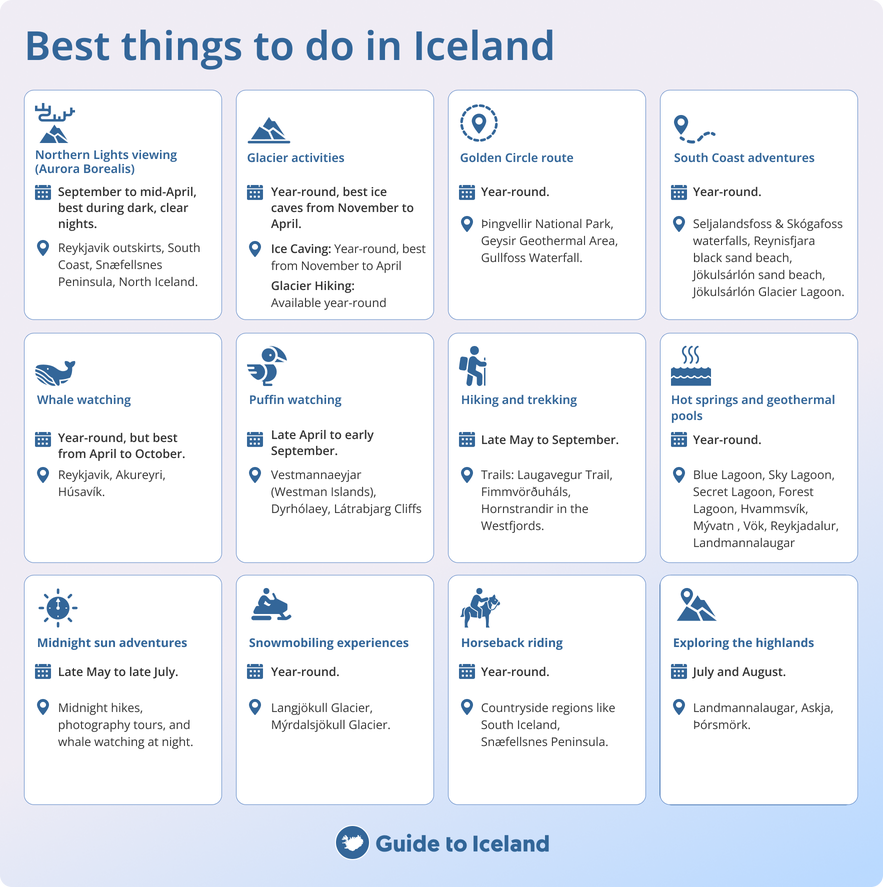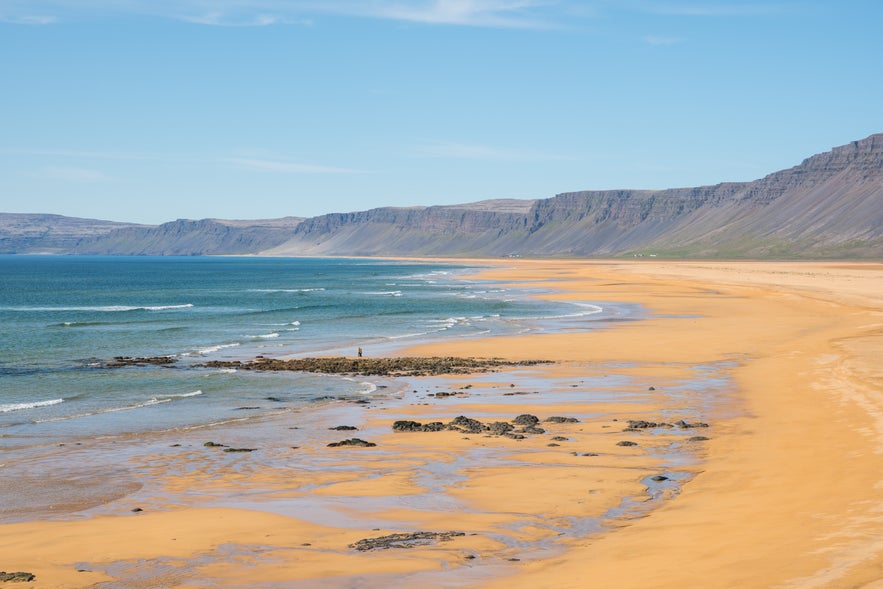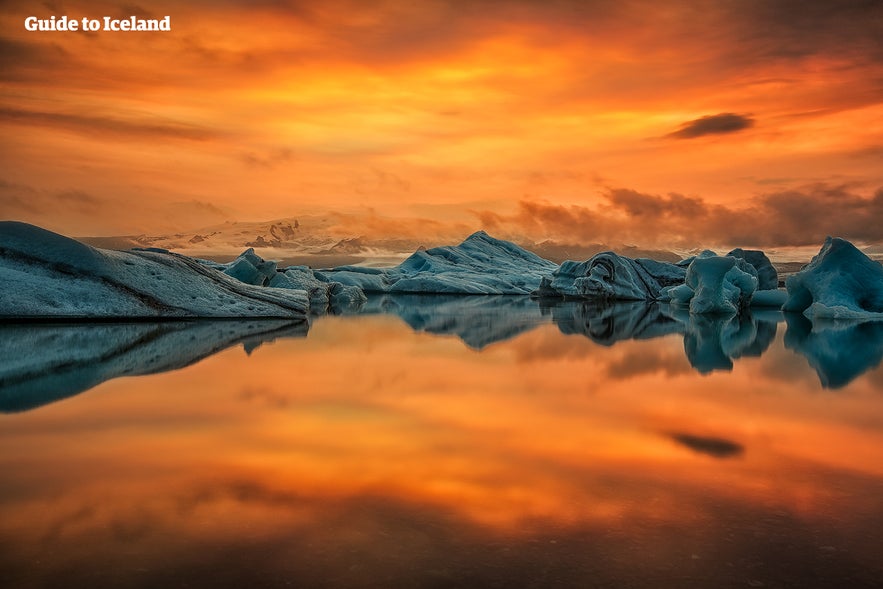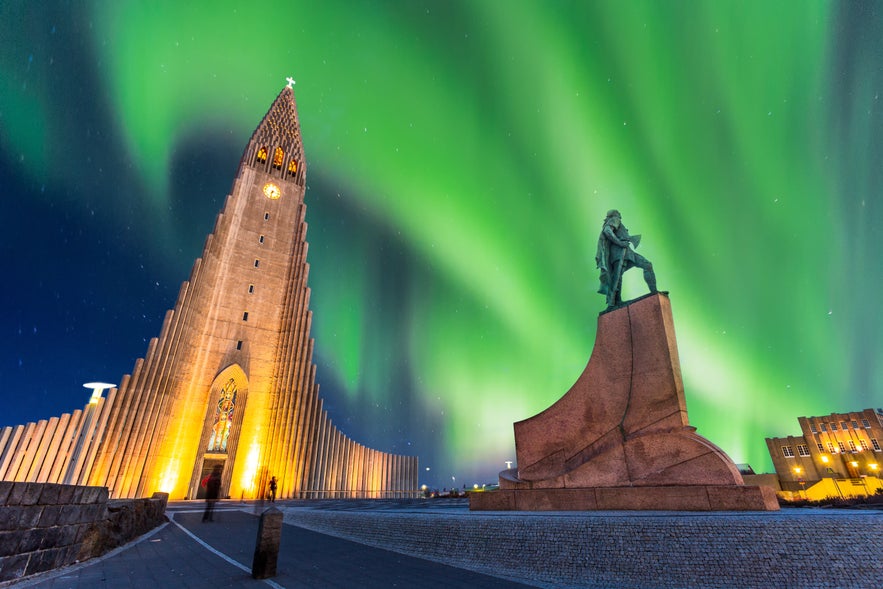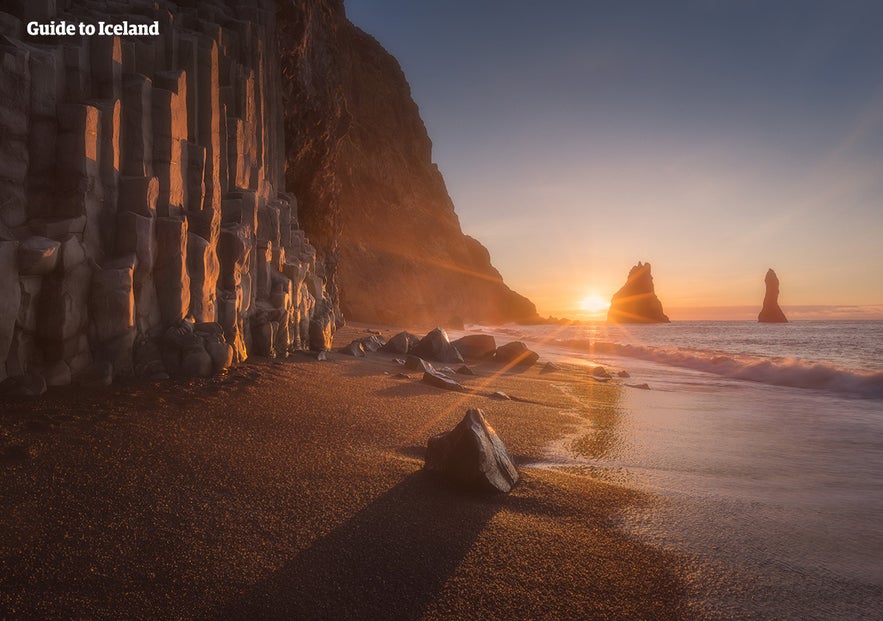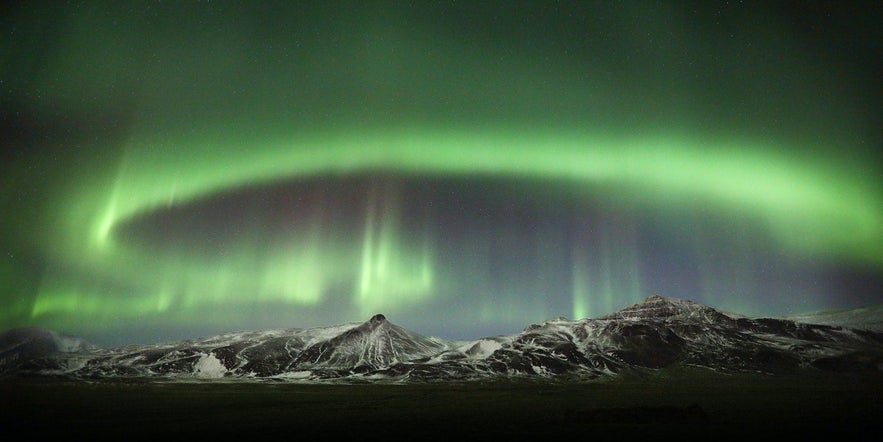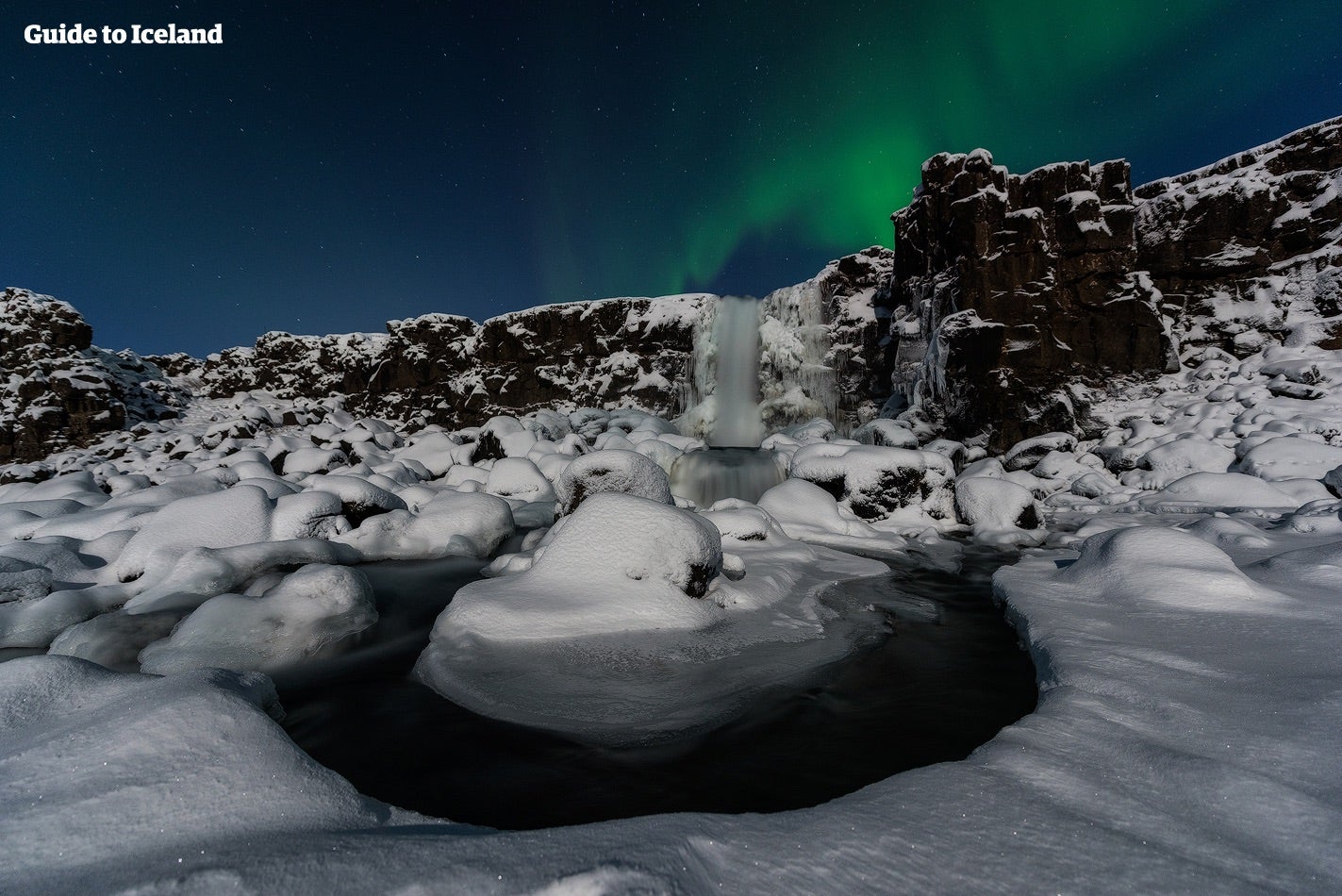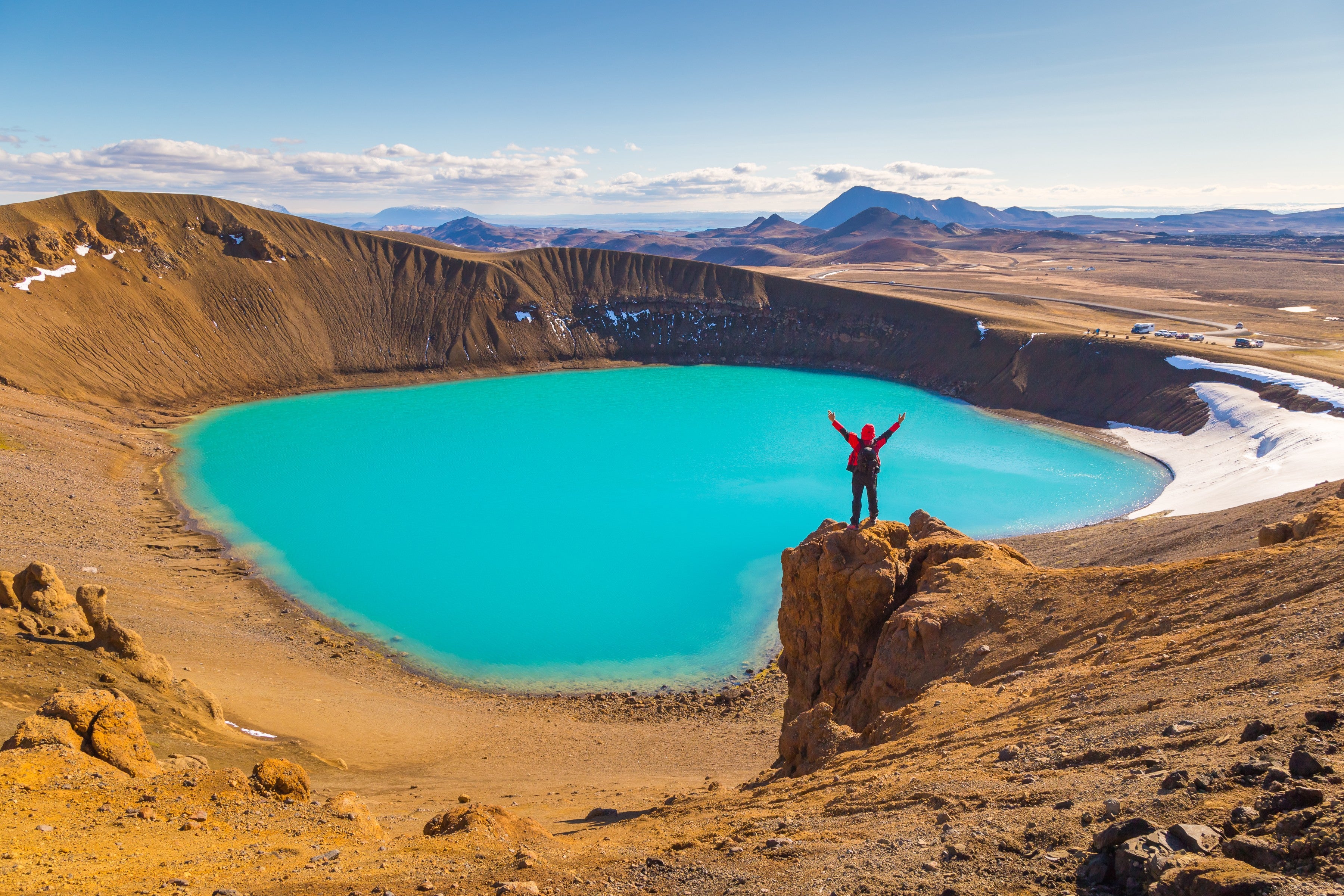Find the top things to do in Iceland and read about where to go and what to see. Whether it's natural wonders, cultural experiences, or hidden gems, learn all about Iceland's must-see attractions.
Iceland is a land of dramatic contrasts, where road trips around the island take you past glaciers and volcanoes, and you can see the northern lights light up dark winter landscapes. With so much beauty and adventure packed into one island, it can be hard to know where to begin!
To make planning easier, this guide highlights what to experience in Iceland, from the top things to do to the best places to visit.
Why You Can Trust Our Content
Guide to Iceland is the most trusted travel platform in Iceland, helping millions of visitors each year. All our content is written and reviewed by local experts who are deeply familiar with Iceland. You can count on us for accurate, up-to-date, and trustworthy travel advice.
One of the most popular things to do in Iceland is to rent a car and see all the attractions by the Ring Road, staying in cozy country hotels along the way. It’s a flexible and scenic way to enjoy nature at your own pace, but you'll also find great options here for those based in Reykjavik.
Whether you're chasing waterfalls, exploring glaciers, or relaxing in geothermal spas, this article covers the very best of Iceland for your dream adventure.
Where to Go in Iceland
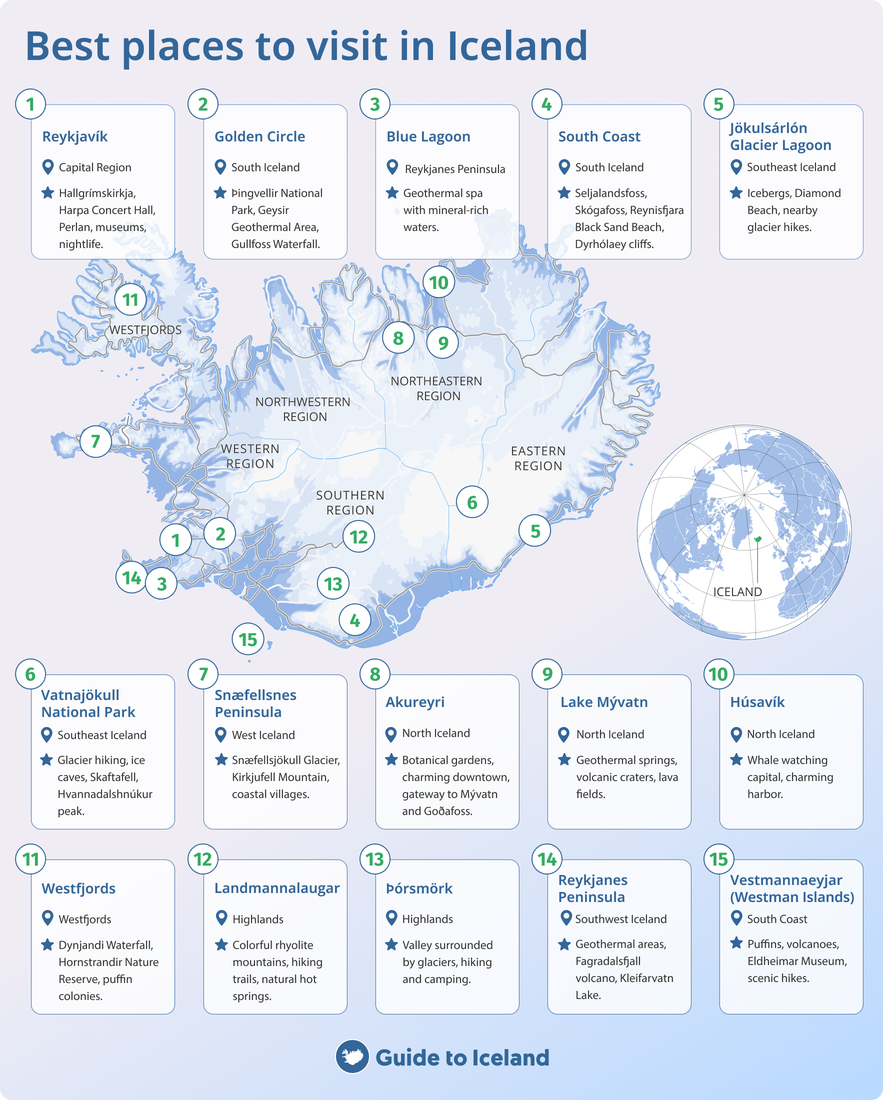
Below, you'll find a short introduction to the best places to visit in Iceland and what each region has to offer, before we dive deeper into the best attractions and activities.
1. Reykjavik - The Capital City

The best place in Iceland to begin a trip is Reykjavik, the country's capital. Reykjavik is located a 45-minute drive from Keflavik International Airport.
The capital is home to some of Iceland's most iconic landmarks, including Hallgrimskirkja Church, the Harpa Concert Hall, and Perlan Museum. You'll also find a thriving food scene that blends traditional Icelandic dishes with modern Nordic cuisine.
Reykjavik is compact and walkable, making it easy to explore neighborhoods filled with colorful houses, street art, and cozy cafes. Many travelers also use the city as a base and join day trips from Reykjavik to reach highlights like the Golden Circle, the South Coast, or the Snaefellsnes Peninsula.
2. The Golden Circle - Iceland's Most Popular Route
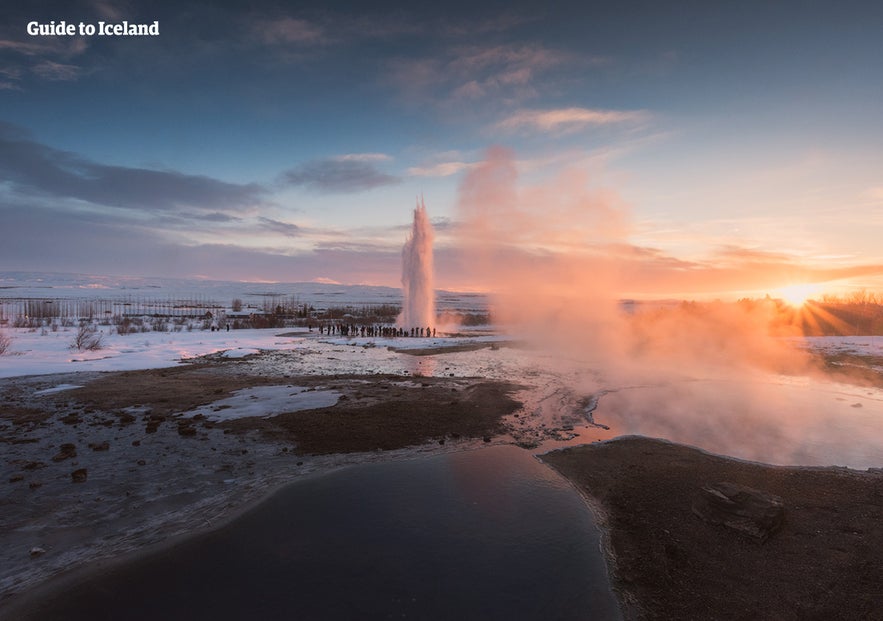
The Golden Circle is one of the most famous sightseeing routes in Iceland, and for good reason.
The route covers three of the country’s most iconic attractions: Thingvellir National Park, a UNESCO World Heritage Site with geological and historic significance; the Geysir Geothermal Area, where the Strokkur Geyser erupts every few minutes; and Gullfoss Waterfall, one of Iceland’s most powerful cascades.
The Golden Circle can be explored on a day trip from Reykjavik, or as a Ring Road detour. You can join a large variety of Golden Circle tours to experience it, including self-drives, guided sightseeing tours, and meet-on-location activities like snorkeling, snowmobiling, horseback riding, and hot spring bathing.
3. The South Coast - Iceland’s Most Scenic Shoreline
 The South Coast is one of the best places to visit in Iceland for road trips and guided tours because of its incredible natural landscapes. This region features many of Iceland’s most famous waterfalls, black sand beaches, and glacier views.
The South Coast is one of the best places to visit in Iceland for road trips and guided tours because of its incredible natural landscapes. This region features many of Iceland’s most famous waterfalls, black sand beaches, and glacier views.
South Iceland is also one of the best regions in Iceland for outdoor activities, with opportunities for glacier hiking, ice caving, and horseback riding.
It can be completed as a day trip from Reykjavik or on guided South Coast tours, but it's recommended to spread the journey over two days for the best experience. The region is full of hidden gems and scenic detours for travelers who have time to go beyond the main highlights.
4. The Snaefellsnes Peninsula - Iceland in Miniature
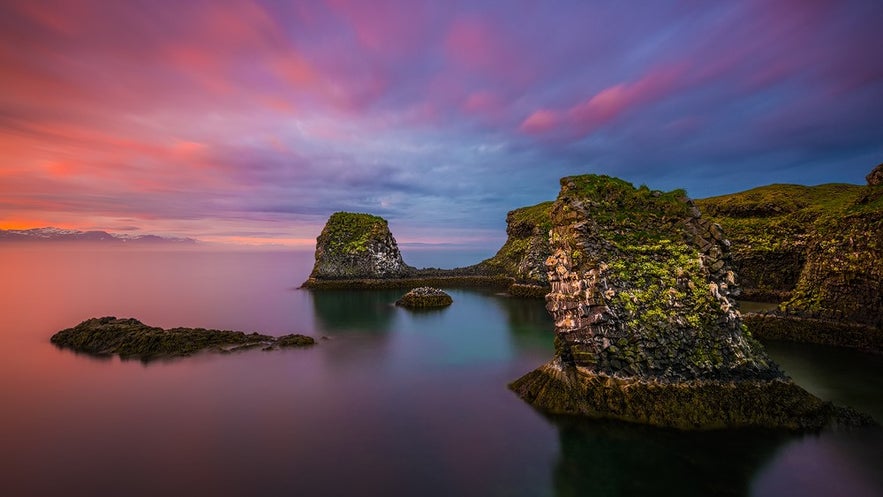
Often called “Iceland in Miniature,” the Snaefellsnes Peninsula brings together many of the country’s most famous landscapes in one scenic region. Within Snaefellsjokull National Park, you’ll find lava fields, volcanic craters, sea cliffs, and striking black sand beaches.
Beyond sightseeing and coastal walks, visitors can explore fishing villages, go whale watching or kayaking, hike beautiful trails, take snowcat tours on Snaefellsjokull Glacier, or venture into dramatic lava caves.
Snaefellsnes works well as a day trip from Reykjavik or a road trip detour from the Ring Road. With Snaefellsnes tours of varying lengths, it's easy to plan a visit that fits your schedule and preferred travel pace.
5. The Eastfjords - Remote Beauty and Coastal Charm
 East Iceland is a peaceful and scenic region, known for winding coastal roads, quiet fishing villages, and dramatic fjords.
East Iceland is a peaceful and scenic region, known for winding coastal roads, quiet fishing villages, and dramatic fjords.
Here, you can find some of the most underrated places to visit in Iceland, including geothermal baths, quiet fjords, hidden waterfalls, and canyons, either independently or by joining Eastfjords tours.
The Eastfjords are usually explored when traveling the whole Ring Road around Iceland, since the area is too far from Reykjavik for a day visit. Alternatively, you can fly from Reykjavik to Egilsstadir, the main town in the east, and continue exploring with a rental car from there.
6. North Iceland - Wildlife and Volcanic Wonders
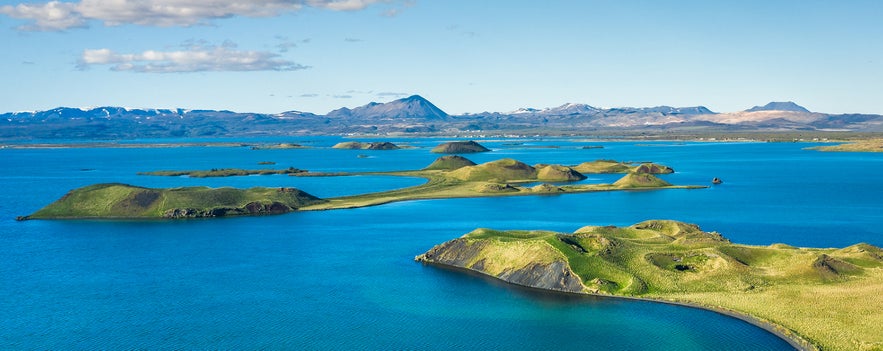
The North Iceland region combines volcanic landscapes, geothermal areas, and rich wildlife. Many of the region’s highlights are linked by the Diamond Circle, a scenic route that includes waterfalls, canyons, geothermal fields, and the whale watching town of Husavik.
In addition to its landscapes, North Iceland is also a place to slow down and enjoy its geothermal baths and hot springs. In winter, it becomes a prime destination for seeing the northern lights and dog sledding tours.
Most travelers visit North Iceland as part of a Ring Road trip, but if you’re traveling directly from Reykjavik, plan at least two or three days to experience the region fully.
7. The Westfjords - Hidden Landscapes and Stunning Coastlines
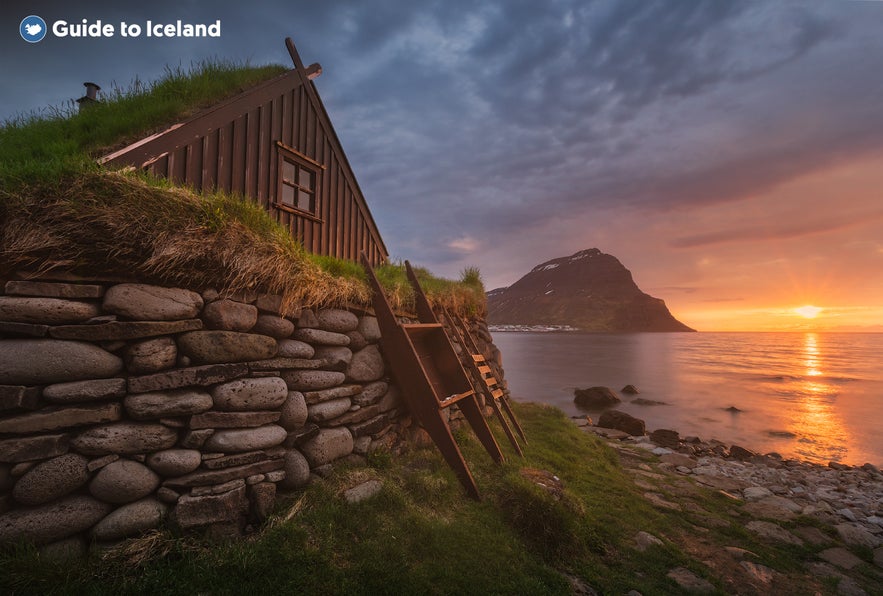 Most travelers in Iceland follow the Ring Road around the country, but few make time for a detour into the Westfjords. As a result, this dramatic and quiet region is often overlooked on travelers' lists of places to visit in Iceland.
Most travelers in Iceland follow the Ring Road around the country, but few make time for a detour into the Westfjords. As a result, this dramatic and quiet region is often overlooked on travelers' lists of places to visit in Iceland.
Here you’ll find sea cliffs filled with puffins, remote beaches, waterfalls, and winding roads through untouched fjords. Popular Westfjords tours and activities include hiking, kayaking, birdwatching, and soaking in natural hot springs.
You can reach the region by driving or flying to Isafjordur and continuing with a rental car. The Westfjords are best visited in summer, when the roads are open and conditions are easier. Plan at least two or three full days in the region to enjoy the highlights at a comfortable pace.
8. The Reykjanes Peninsula - Geothermal Beauty Near Reykjavik
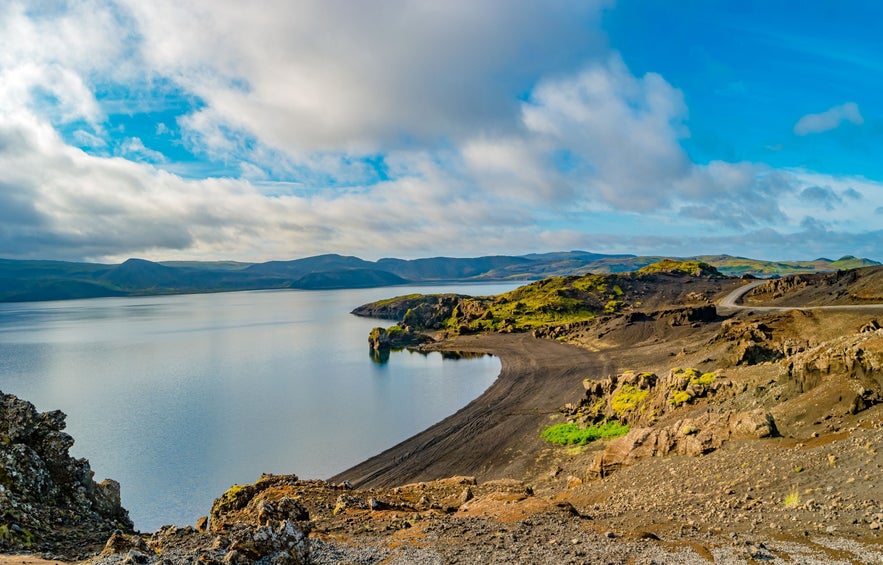 The Reykjanes Peninsula is the first and last part of Iceland most travelers see, as it's home to Keflavik International Airport.
The Reykjanes Peninsula is the first and last part of Iceland most travelers see, as it's home to Keflavik International Airport.
The most famous attraction on the Reykjanes Peninsula is the Blue Lagoon spa, surrounded by volcanic landscapes. But the peninsula has much more to offer, and Reykjanes tours highlight the top attractions in the area.
For those with half a day before departure or after arrival, Reykjanes is easy to explore by car. Places to visit in the region include steaming geothermal fields, lava plains, lighthouses, rugged sea cliffs, and Iceland’s newest volcano, the Sundhnukagigar Craters.
9. The Silver Circle - West Iceland’s Best-Kept Secrets
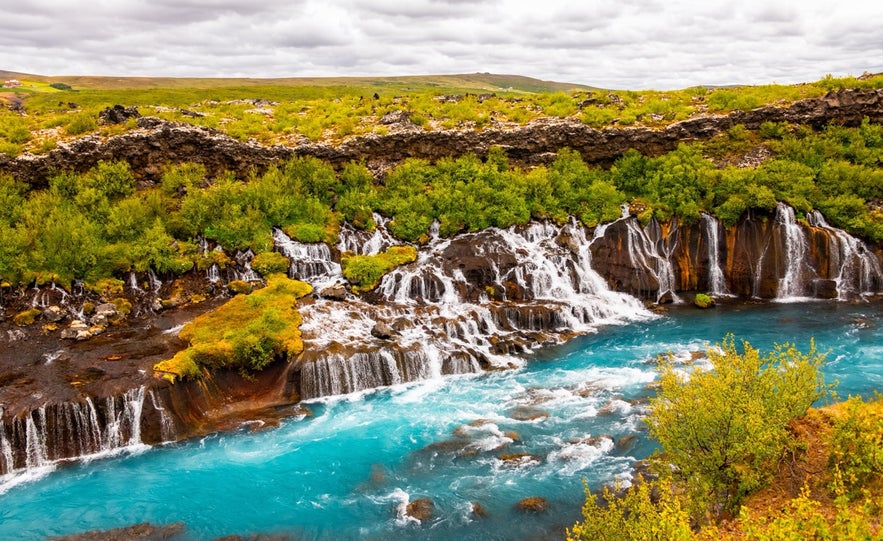
The Silver Circle is known for its waterfalls, hot springs, and historic sites. Travelers also find peaceful valleys, mountain views, and geothermal baths in the area. Many visitors also add tours on the Langjokull Glacier to their Silver Circle itinerary, with options to explore Iceland’s second-largest glacier.
Most travelers experience the Silver Circle in a single day. The route can also be combined with nearby regions if you have more time.
10. The Highlands - Iceland’s Dramatic Wilderness
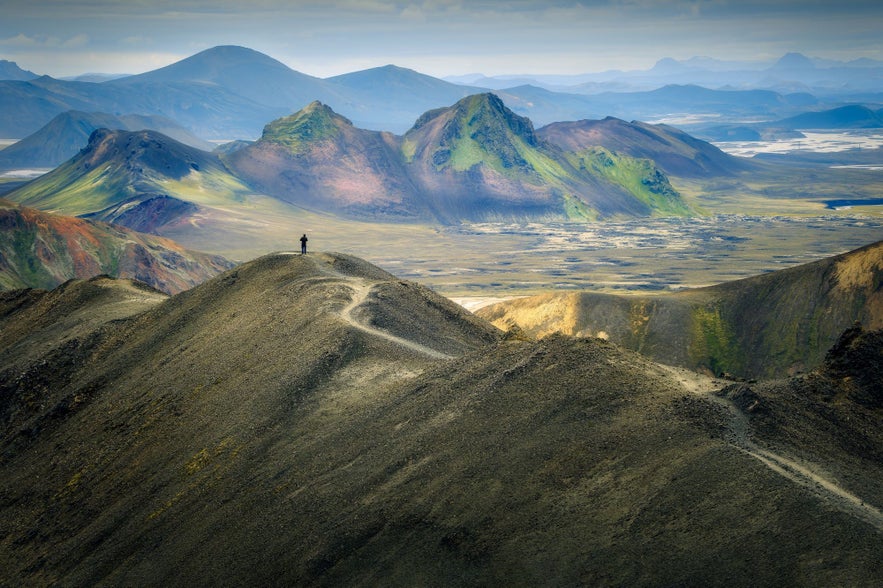 The most remote region to visit in Iceland is home to some truly incredible hidden wonders. The Highlands are filled with colorful rhyolite mountains, steaming geothermal valleys, black sand deserts, and glacial rivers.
The most remote region to visit in Iceland is home to some truly incredible hidden wonders. The Highlands are filled with colorful rhyolite mountains, steaming geothermal valleys, black sand deserts, and glacial rivers.
Travelers go to the Highlands to hike, soak in natural hot springs, or simply take in the raw, untouched scenery. This vast wilderness is only accessible on guided Highland tours or, in summer, with 4x4 rental vehicles. Make sure to look into which F-Roads (mountain roads) you'll need to take before you embark on your journey.
Now that you have an introduction to Iceland’s regions, it should be easier to decide where to go based on how much time you have and the kind of experiences you're interested in. Read on to learn what to see in Iceland, before we dive deeper into all the best things to do!
What to See in Iceland
It's no secret that Iceland has some of the world's most unique and stunning nature. Much of the landscape has been shaped over time by volcanoes and glaciers, creating dramatic contrasts.
The country’s small population makes this even more special, as most of its landscapes remain untouched and pristine. The best things to see in Iceland include powerful waterfalls, vast glaciers, remarkable wildlife, the northern lights in winter, and the midnight sun in summer.
Below is a short overview of the top 10 natural wonders to help you decide on what to see in Iceland.
1. Northern Lights - Iceland’s Magical Winter Light Show

From September to April, you can see the magical northern lights in Iceland. Many visitors consider this one of the best things to see in Iceland and a highlight of their trip.
You can hunt for them yourself, but guided northern lights tours improve your chances by taking you to the secret places with the best viewing conditions.
2. Waterfalls - Countless Wonders Across the Landscape
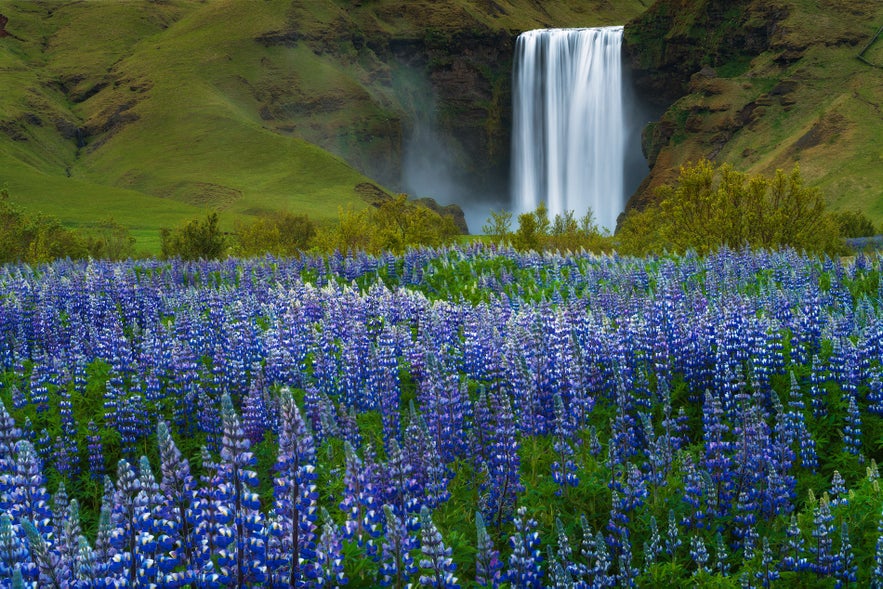 Iceland is known for its beautiful waterfalls, many of which are situated right by the Ring Road, like the Skogafoss Waterfall. Several waterfalls also have folklore tied to them, adding a sense of mystery to the sites.
Iceland is known for its beautiful waterfalls, many of which are situated right by the Ring Road, like the Skogafoss Waterfall. Several waterfalls also have folklore tied to them, adding a sense of mystery to the sites.
Some, like Gullfoss, are massive and powerful, while others are smaller and more delicate. There are even some waterfalls you can walk behind, with Seljalandsfoss being the most famous example.
3. Glaciers and Glacier Lagoons - Icy Giants and Floating Icebergs
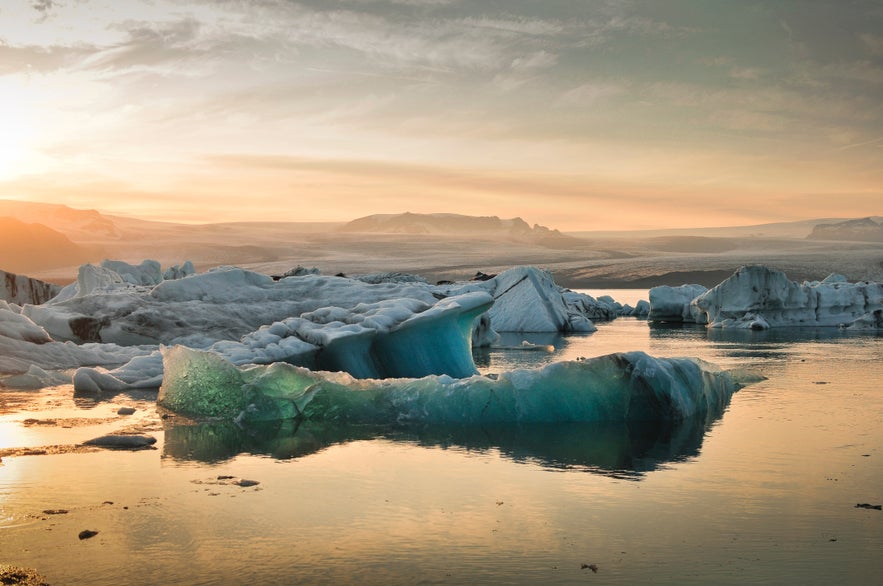
Glaciers are undoubtedly one of the best things to see in Iceland. They cover large parts of the country and feed spectacular lakes like Jokulsarlon Glacier Lagoon, where icebergs drift out to sea.
For a closer experience of these striking natural features, you can join glacier tours to hike on the ice or visit natural ice caves, both unforgettable things to do in Iceland.
4. Ice Caves - Explore Hidden Ice Formations
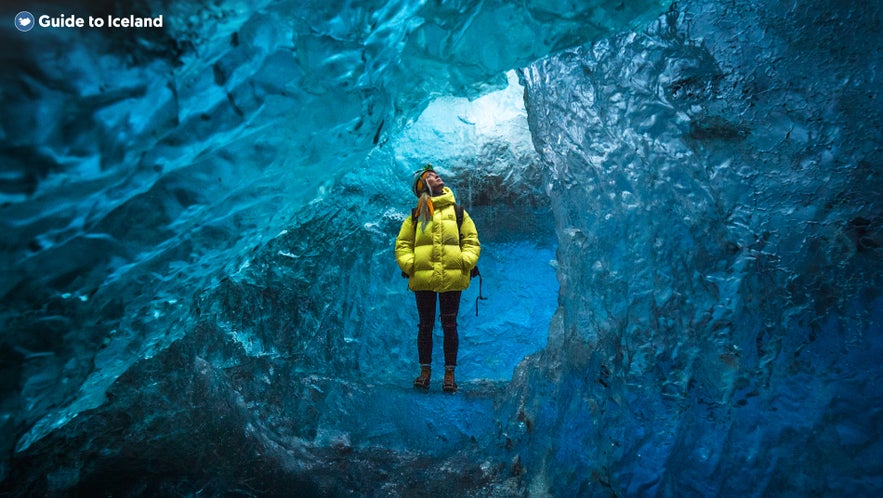
In winter, ice caves naturally form inside Iceland’s glaciers. These shimmering blue caves can only be visited on guided ice cave tours, which typically run from November to March.
The most famous is the Crystal Blue Ice Cave in Vatnajokull Glacier. The only ice cave in Iceland that can be visited year-round is Katla Ice Cave, located beneath Myrdalsjokull Glacier.
5. Black Sand Beaches - Surreal Volcanic Shores
 Formed by volcanic activity, the black sand beaches in Iceland are strikingly beautiful. The most famous beach to visit in Iceland is Reynisfjara, known for its basalt cliffs and crashing waves.
Formed by volcanic activity, the black sand beaches in Iceland are strikingly beautiful. The most famous beach to visit in Iceland is Reynisfjara, known for its basalt cliffs and crashing waves.
Diamond Beach by Jokulsarlon Glacier Lagoon is another stunning beach, known for its glistening ice. One of the most popular photography locations is Solheimasandur, a large black sand plain home to the DC3 Plane Wreck.
6. Volcanoes and Lava Fields - The Raw Power of the Earth
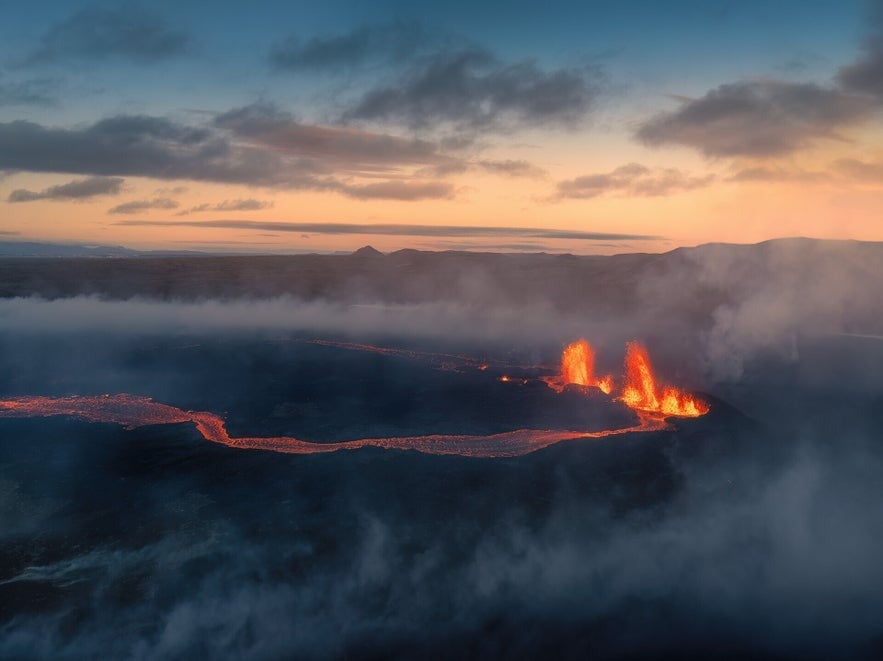 Volcanoes in Iceland have shaped the landscape, creating black sand plains, rugged lava fields, and dramatic craters. The recent eruptions on the Reykjanes Peninsula remind us that Iceland is still evolving.
Volcanoes in Iceland have shaped the landscape, creating black sand plains, rugged lava fields, and dramatic craters. The recent eruptions on the Reykjanes Peninsula remind us that Iceland is still evolving.
You can hike across ancient lava fields, visit volcanic craters, or even witness new eruption sites like the Sundhnukagigar Craters on guided volcano tours. Volcanic landscapes remain one of the most epic things to see in Iceland.
7. Whales - Meet the Giants of the Ocean

Iceland is a top destination for spotting whales, with whale watching tours available year-round. Sightings include minke whales, humpbacks, and dolphins, occasionally even orcas and blue whales.
The best tours depart from Husavik, often called the “whale-watching capital of Europe,” as well as Reykjavik, Akureyri, and other smaller coastal towns around Iceland.
8. Puffins - Iceland’s Most Beloved Seabirds
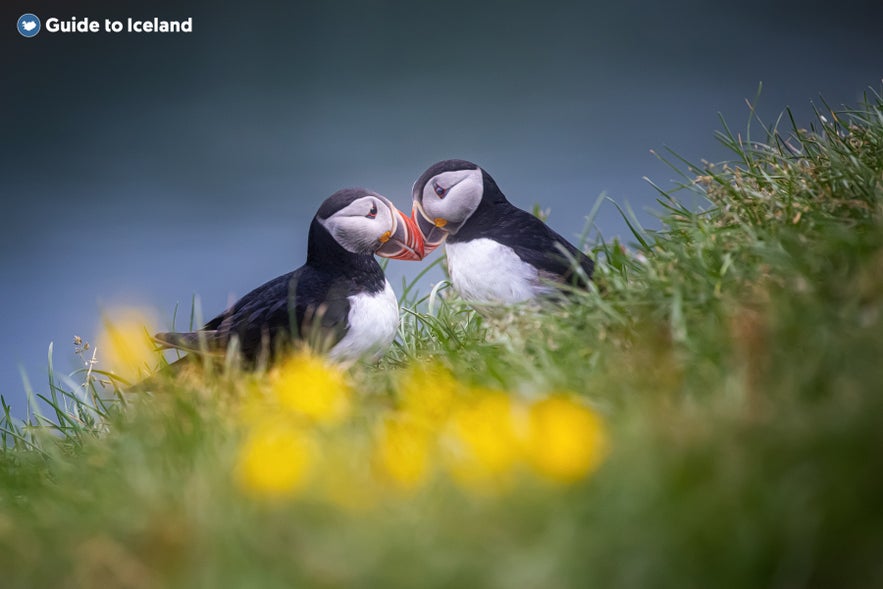
Puffins are one of the most popular things to see in Iceland, nesting on sea cliffs from May to August. The biggest puffin colony in the world can be found on the Westman Islands off the South Coast.
You can join birdwatching tours to see puffins up close. They’re sometimes also spotted on whale-watching trips. Puffin viewing spots can be found all around the Icelandic coast.
9. Hot Springs and Geothermal Areas - Where Fire Meets Water
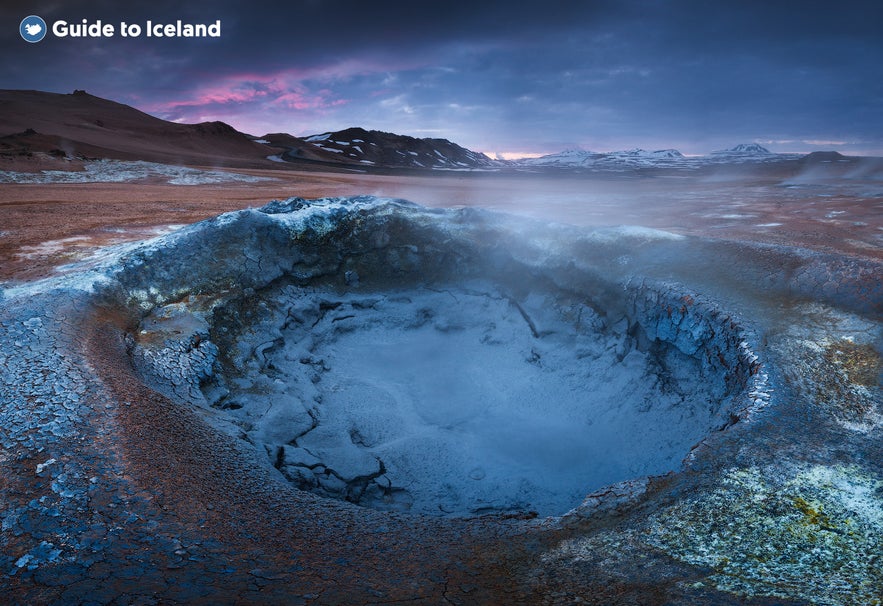
When researching what to see in Iceland, geothermal hot springs are always near the top of the list. Some are wild and remote, while others have been developed into geothermal spas.
Travelers can join hot spring tours to relax in naturally heated pools, or visit geothermal areas with steaming vents, colorful mineral soils, and bubbling mud pools.
10. Midnight Sun - Endless Daylight in the Arctic Summer
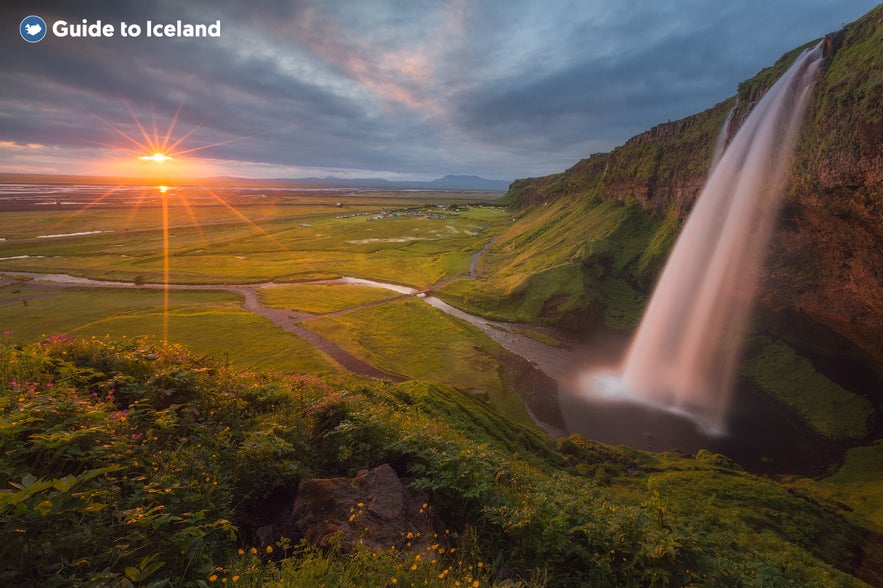 One of the most incredible things to experience in Iceland is the midnight sun, which is when the sun barely sets in summer. Around the solstice in June, the evenings stay bright well past midnight.
One of the most incredible things to experience in Iceland is the midnight sun, which is when the sun barely sets in summer. Around the solstice in June, the evenings stay bright well past midnight.
Midnight sun tours invite travelers to enjoy long days for sightseeing, photography, and outdoor adventures. The extended daylight is why summer is one of the best times to visit Iceland.
Keeping these natural highlights in mind will help you decide what unique features of Iceland to focus on. Up next, we’ll walk you through the top attractions in Iceland to include in your itinerary, to help you make the most of your adventure.
Top 10 Attractions in Iceland
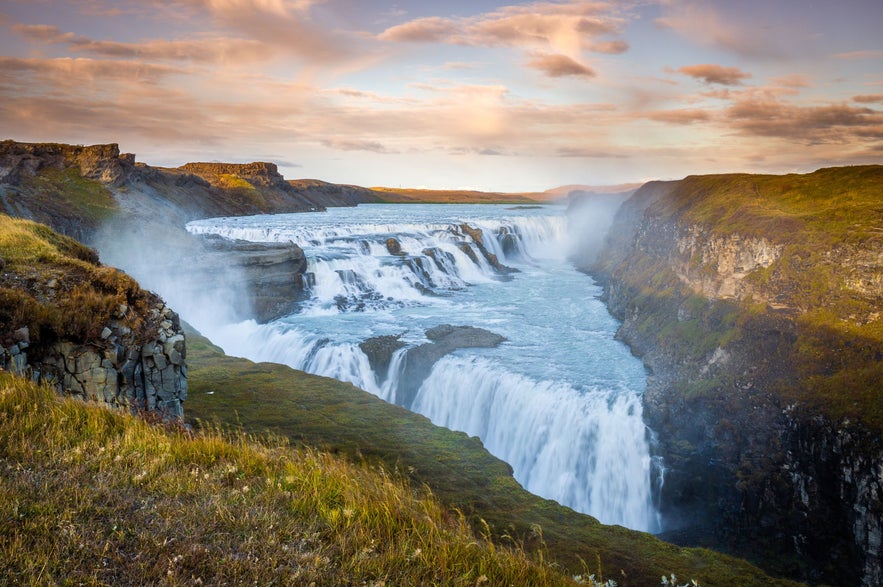
Iceland is packed with unforgettable natural wonders. While many highlights have already been mentioned, the following stand out as the very top attractions to visit in Iceland.
10. Kirkjufell Mountain
Kirkjufell Mountain is one of the most iconic attractions to visit in Iceland. Rising like a pyramid on the Snaefellsnes Peninsula, it’s often called “the most photographed mountain in Iceland,” and it’s easy to see why once you stand in front of it.
Paired with the nearby Kirkjufellsfoss Waterfall, it creates one of the most photogenic scenes in Iceland.
-
Distance from Reykjavik: About 115 miles (185 kilometers), 2.5 hours by car.
-
How to get there: Best reached on a day trip to the Snaefellsnes Peninsula. Both guided tours and self-drives allow you to combine Kirkjufell with other highlights like Snaefellsjokull Glacier and Djupalonssandur Beach.
9. Lake Myvatn Geothermal Area
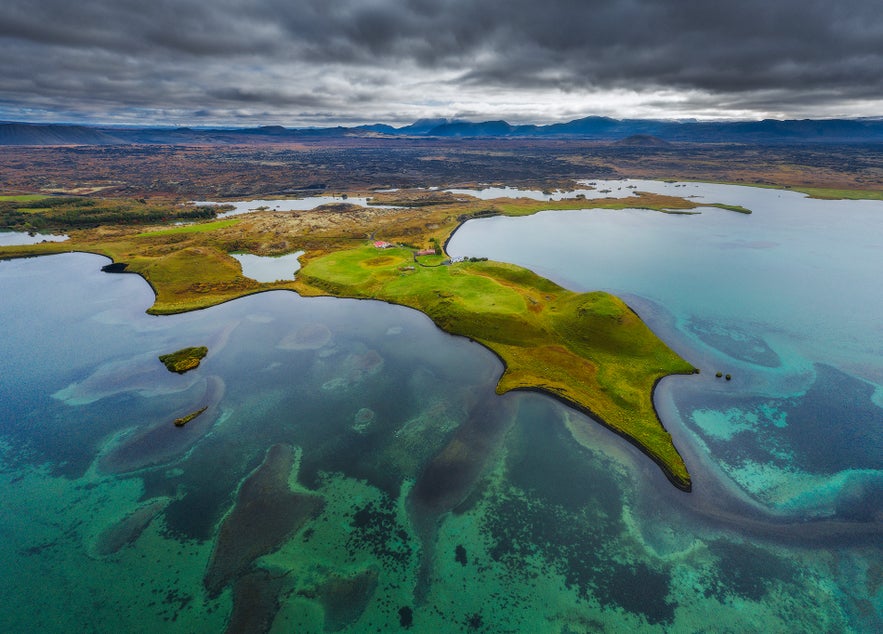
The Lake Myvatn region in North Iceland is an incredible place to visit that offers dramatic volcanic landscapes, geothermal activity, and rich birdlife.
Highlights include the lava formations of Dimmuborgir, bubbling mud pots at Hverir, and pseudocraters formed by past eruptions. Travelers can also relax in the Earth Lagoon, formally known as Myvatn Nature Baths. It's a peaceful alternative to the Blue Lagoon with sweeping lake views.
-
Distance from Reykjavik: About 300 miles (480 kilometers), 6–7 hours by car. The closest town is Akureyri, about 55 miles (90 kilometers) away.
-
How to get there: Best visited on a North Iceland or Diamond Circle tour. Easily included on a Ring Road self-drive itinerary.
8. Thingvellir National Park
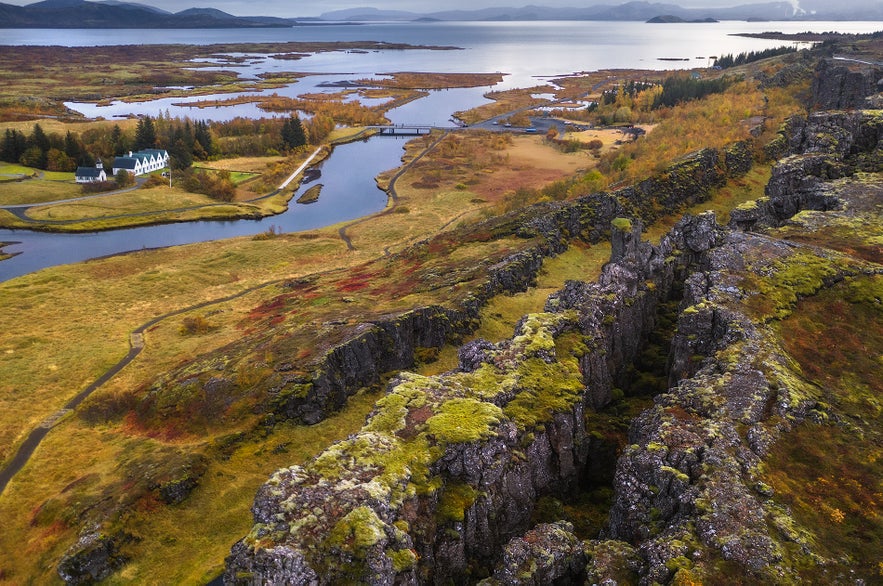 A UNESCO World Heritage Site, Thingvellir National Park is where Iceland’s first parliament was established in 930 AD. It’s also a geological wonder, with visible rift valleys between the Eurasian and North American tectonic plates.
A UNESCO World Heritage Site, Thingvellir National Park is where Iceland’s first parliament was established in 930 AD. It’s also a geological wonder, with visible rift valleys between the Eurasian and North American tectonic plates.
Visitors at Thingvellir National Park can explore the dramatic Almannagja Gorge, see Oxararfoss Waterfall, and even snorkel in the crystal-clear waters of Silfra Fissure.
-
Distance from Reykjavik: About 30 miles (47 kilometers), 45 minutes by car.
-
How to get there: Thingvellir is one of the three main stops on the Golden Circle, included on nearly all guided tours and easily reached by self-drive.
7. Vatnajokull National Park
Vatnajokull National Park covers nearly 15% of Iceland and includes Europe’s largest glacier, volcanoes, canyons, and countless natural wonders.
One of the most popular areas is Skaftafell Nature Reserve, where you can join glacier hikes and visit Svartifoss, the striking basalt-column waterfall that inspired Hallgrimskirkja Church in Reykjavik.
-
Distance from Reykjavik: About 200 miles (320 kilometers), 4.5–5 hours by car.
-
How to get there: Best visited on a multi-day South Coast or Ring Road trip. Guided tours often combine Skaftafell activities with Jokulsarlon Glacier Lagoon.
6. Skogafoss Waterfall
Skogafoss is one of Iceland’s most recognized waterfalls, located on the South Coast. Its wide, powerful cascade is perfectly symmetrical and often framed by rainbows in the spray.
A staircase beside the falls leads to the top, where you can enjoy sweeping views of the coastline and the Skoga River.
-
Distance from Reykjavik: About 95 miles (150 kilometers), just over 2 hours by car.
-
How to get there: Located directly off the Ring Road, Skogafoss is easy to include on a South Coast day trip or multi-day self-drive. Most guided tours of the South Coast also stop here.
5. The Blue Lagoon
The Blue Lagoon geothermal spa is one of Iceland’s most famous attractions, located between Keflavik Airport and Reykjavik. Its warm, mineral-rich waters are perfect for relaxing before or after a flight.
You can visit year-round, but you'll have to book your Blue Lagoon tickets in advance, especially in high season.
-
Distance from Reykjavik: About 30 miles (50 kilometers), 45 minutes by rental car.
-
How to get there: Easy to reach by car or shuttle from Reykjavik or Keflavik Airport. Many airport transfers include a stop at the lagoon.
4. Gullfoss Waterfall
A key stop on the Golden Circle route, Gullfoss (meaning “Golden Falls”) is a powerful two-tiered waterfall that plunges into a rugged canyon.
There are well-maintained walking paths with great viewpoints, and it’s easily reached on a Golden Circle day trip from Reykjavik, either with a guided tour or a self-drive trip.
-
Distance from Reykjavik: About 72 miles (116 kilometers), 1.5–2 hours by car. The classic Golden Circle route is 190 miles (300 kilometers) and takes 6-8 hours.
-
How to get there: Easy to visit as part of a Golden Circle day trip, either by self-drive or guided tour departing from Reykjavik.
3. Reynisfjara Black Sand Beach
Just outside the town of Vik on the South Coast, Reynisfjara is known for its striking black sands, basalt columns, sea stacks, and strong Atlantic waves.
It’s one of Iceland’s most photographed spots, but be cautious as sneaker waves here are powerful and dangerous.
-
Distance from Reykjavik: About 115 miles (185 kilometers), 2.5–3 hours by car.
-
How to get there: Included on most South Coast day tours or accessible on a self-drive along the Ring Road.
2. Seljalandsfoss Waterfall
Seljalandsfoss Waterfall on the South Coast is unique because you can walk behind it for a view from inside the cascade.
It’s visible from the Ring Road and is one of the most accessible and scenic stops for travelers heading toward Skogafoss Waterfall, Vik, or the Jokulsarlon Glacier Lagoon.
-
Distance from Reykjavik: About 80 miles (130 kilometers), 2 hours by car.
-
How to get there: Easily accessible by self-drive and a key stop on any guided South Coast tour from Reykjavik.
1. Jokulsarlon Glacier Lagoon
The Jokulsarlon Glacier Lagoon is often considered the number one attraction in Iceland, making it a highlight of any trip to Southeast Iceland. Here, massive icebergs break off from Breidamerkurjokull Glacier and drift across the lagoon before reaching the sea.
You can walk along the shoreline, take a Jokulsarlon boat tour among the ice, or walk to the shore to see the famous Diamond Beach, where icebergs wash up on the black sand.
-
Distance from Reykjavik: About 235 miles (380 kilometers), 5–6 hours by car.
-
How to get there: Best reached with a two-day self-drive trip with an overnight stay along the South Coast. It’s also included in some guided tours of South Iceland or the Ring Road.
Top 15 Must-Do Experiences in Iceland
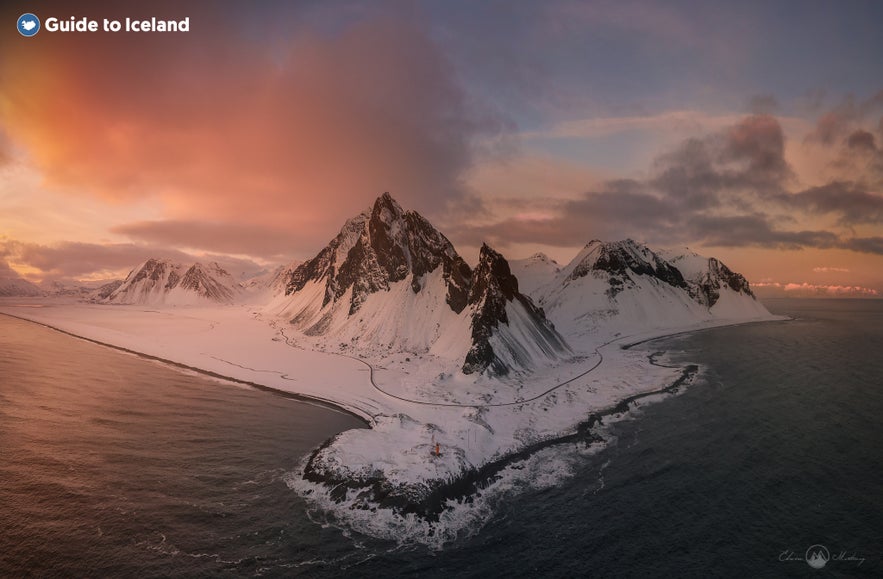
Whether you’ve decided to self-drive around Iceland or take a tour, we’ve rounded up not only the top 10 things to do in Iceland but the top 15 must-do experiences!
15. Embark on a Road Trip and See the Whole of Iceland

There’s nothing quite like the freedom of the open road, where you can pull over for hidden gems like a nameless waterfall, a herd of Icelandic horses, or a jaw-dropping mountain view. The best road trip itineraries also feature the top attractions of the Ring Road, offering endless highlights.
Summer self-drive tours make the most of the midnight sun, giving you long days to explore Iceland’s top attractions and hidden corners at a relaxed pace. Winter self-drive tours offer a different kind of adventure, with snowy landscapes and nights spent chasing the northern lights.
 These are some of the very top-rated self-drive tours for an unforgettable adventure in Iceland:
These are some of the very top-rated self-drive tours for an unforgettable adventure in Iceland:
-
10-Day Self-Drive Tour of the Complete Ring Road of Iceland - See it all with this full circle around the country, covering top highlights like the South Coast, Eastfjords, Lake Myvatn, and the Snaefellsnes Peninsula.
-
1-week Summer Self-Drive Tour of the Ring Road - A faster-paced version of the Ring Road for those with limited time. Ideal in summer, when you can take advantage of long daylight hours to explore more each day.
-
1-Week Northern Lights Self-Drive Tour of South & West Iceland with Ice Caving - Designed for winter travel, chase the northern lights, explore icy landscapes, and visit a natural ice cave as you travel through the south and west.
While guided tours are excellent for those who prefer to travel without a rental car, nothing matches the flexibility and intimacy of exploring at your own pace.
14. Visit Fishing Villages and See Wild Reindeer in the Eastfjords
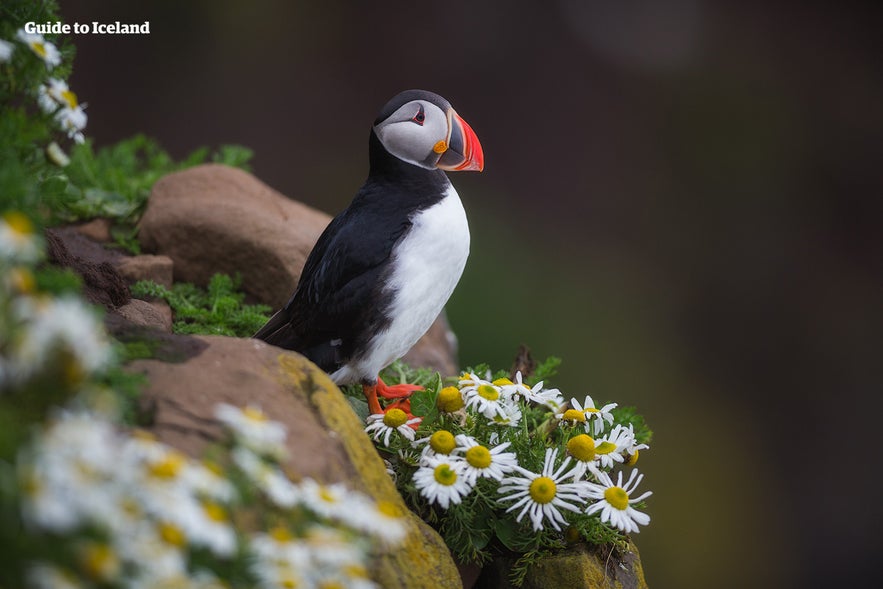 The Eastfjords are often sped through by travelers rushing the Ring Road, but those who make the journey discover colorful fishing villages, dramatic fjords, and a slower pace of life. It’s a quiet corner of the country where traditions remain strong and nature feels close at hand.
The Eastfjords are often sped through by travelers rushing the Ring Road, but those who make the journey discover colorful fishing villages, dramatic fjords, and a slower pace of life. It’s a quiet corner of the country where traditions remain strong and nature feels close at hand.
East Iceland is included in a handful of guided multi-day tours and self-drive tours along the Ring Road. If you decide to explore this area, these are the top towns to visit in Iceland's Eastfjords:
-
Egilsstadir - The region's largest town, home to some of the Eastfjords' best restaurants.
-
Seydisfjordur - A small town famous for its rainbow-painted street, blue church, & waterfalls.
-
Djupivogur - A slow-paced coastal village known for birdwatching and a popular sculpture trail.
-
Faskrudsfjordur - A town with a strong French heritage, reflected in bilingual street signs.
-
Borgarfjordur Eystri - A scenic village with great hiking and a lot of puffins during summer.
Beyond the villages, there are many incredible places to see in East Iceland. Landmarks include Vestrahorn Mountain on the southeast coast, Studlagil Canyon near Egilsstadir, and Hengifoss Waterfall, set in striking red and black cliffs. Lagarfljot Lake, said to hide a mythical serpent, adds a touch of folklore to the region.
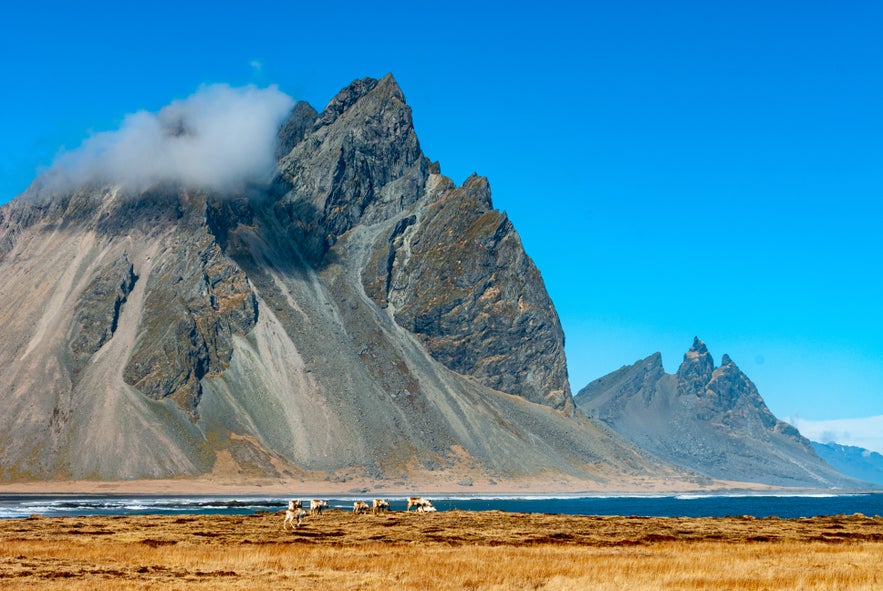 One of the most unique things to do while exploring the Eastfjords is spotting reindeer. East Iceland is the only region where you can see reindeer herds roaming in the wild.
One of the most unique things to do while exploring the Eastfjords is spotting reindeer. East Iceland is the only region where you can see reindeer herds roaming in the wild.
The reindeer in Iceland were originally brought from Norway in the 18th century and now number in the thousands, moving between the Highlands in summer and coastal areas in winter.
For the best chance of seeing them in the wild, consider a Reindeer super jeep tour with local guides who know where herds are most active. The Reindeer Park in Egilsstadir also offers a chance to meet two rescued reindeer up close!
13. Explore Untouched Nature in the Remote Westfjords
Exploring the Westfjords is one of the most adventurous things to do in Iceland, ideal for second-time visitors and travelers who appreciate dramatic landscapes and solitude.
The Westfjords are one of Iceland’s most remote regions, far from the Ring Road and rarely visited. The best time to visit is during the warmer months, when most roads are clear, and summer self-drive tours are the best way to experience the region.
Isafjordur is the main town in the Westfjords. Beyond scenic valleys and fjord views, you'll find plenty of shops, services, and things to do in Isafjordur, along with, in our opinion, the best fish restaurant in Iceland. The accommodations in Isafjordur make a great base for a Westfjords adventure.
Driving here is part of the experience, with long winding roads that trace the fjords. Be prepared for gravel sections and slower journeys, but the dramatic views make it worthwhile, especially when reaching some of the top natural attractions in the Westfjords:
-
Dynjandi Waterfall – A stunning, multi-tiered cascade often called Iceland’s most beautiful waterfall. It's the focal point of many Westfjords tours.
-
Latrabjarg Cliffs – Europe’s westernmost point and a top puffin-watching spot from May to August, reached by scenic fjord roads with dramatic coastal views.
-
Raudisandur Beach – A peaceful red-gold sand beach stretching for miles, named one of the world’s best by Lonely Planet in 2025.
-
Hornstrandir Nature Reserve – Iceland’s most remote region, reachable only by boat. Perfect for hiking tours and spotting arctic foxes in untouched wilderness.
The region is also home to small, scenic towns that provide basic services and easy access to top attractions. Patreksfjordur is the closest town to Latrabjarg Cliffs and Raudisandur Beach, while Holmavik, on the eastern edge of the Westfjords, is home to the unusual Museum of Sorcery and Witchcraft.
12. Experience the Midnight Sun of Icelandic Summer
Visiting Iceland in summer means experiencing one of the country’s most magical natural phenomena, the midnight sun.
From June to early August, the sun barely dips below the horizon, casting golden light late into the night and creating long, glowing evenings perfect for exploring.
Thanks to the extended daylight, you can fit more into your days, from evening hikes and sightseeing to late-night photography sessions. The unique lighting conditions also make Iceland’s landscapes feel even more surreal, especially in the highlands, on the coastline, and by waterfalls.
There are many midnight sun tours available, timed to take full advantage of the golden hours. These tours offer a memorable way to enjoy Iceland's natural beauty under a glowing night sky:
-
Exciting Midnight Sun ATV Tour from Reykjavik - Ride through rugged lava fields and mountain trails just outside the city on this thrilling ATV tour, timed to catch the midnight sun.
-
3-Hour Midnight Sun Kayaking Tour by Kirkjufell Mountain - Paddle along calm coastal waters near Iceland’s most photographed mountain while the sun hangs low on the horizon.
-
Midnight Sun Whale Watching Tour from Reykjavik - Head out from the capital on an evening boat tour to spot whales, dolphins, and seabirds under the soft, glowing light.
The midnight sun also changes the rhythm of life. It's the main time for festivals in Iceland and outdoor concerts, and even casual gatherings stretch late into the night, giving visitors a chance to experience Iceland’s culture in a way that only happens under endless daylight.
11. Admire Iceland’s Most Famous Mountain on the Snaefellsnes Peninsula
Kirkjufell Mountain is one of the most photographed peaks in Iceland. Its pointed shape beside Kirkjufellsfoss Waterfall makes it instantly recognizable, and fans of Game of Thrones will know it as the “Arrowhead Mountain.”
The Snaefellsnes Peninsula is often called “Iceland in Miniature” for the way it brings together so many landscapes in one place. Just two hours from Reykjavik, you can see everything from glaciers to volcanoes, black sand beaches, lava fields, and dramatic sea cliffs.
Because of this variety and accessibility, Snaefellsnes tours are popular both as day trips from Reykjavik and as detours on longer Ring Road journeys.
Stykkisholmur is the main town of the peninsula, with a harbor, restaurants, and cultural attractions. It also offers ferry links to the Westfjords and Flatey Island. Smaller villages like Grundarfjordur, Olafsvik, and Hellissandur also provide services and tour options.
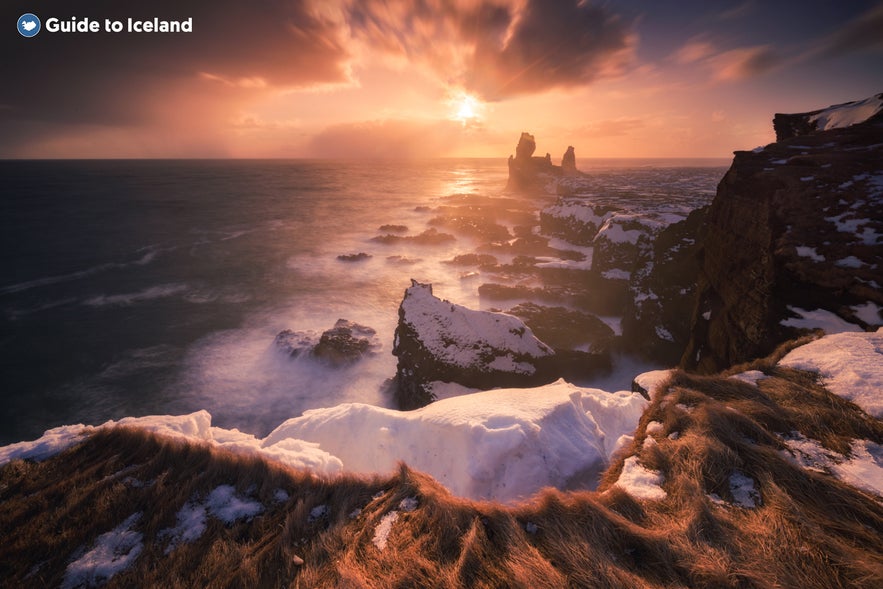
Some of the best things to do on the Snaefellsnes Peninsula include visiting the following iconic natural attractions:
-
Kirkjufell Mountain – The most photographed peak in Iceland, beside Kirkjufellsfoss Waterfall.
-
Snaefellsjokull Glacier – A glacier-capped volcano surrounded by a national park.
-
Londrangar Cliffs – Basalt sea stacks and cliffs with seabirds and ocean views.
-
Arnarstapi & Hellnar – Fishing villages linked by a coastal trail with cliffs and lava formations.
-
Djupalonssandur Beach – Black beach with lava rocks, shipwreck remains, and old tales.
-
Budir Church – A striking black church in a lava field with views of Snaefellsjokull.
The Snaefellsnes Peninsula offers a compact yet unforgettable snapshot of Iceland. It can all be explored on a Snaefellsnes day trip from Reykjavik. Travelers who want more time can base themselves at one of the many great places to stay on the Snaefellsnes Peninsula and explore at a slower pace.
10. Hike the Stunning Highlands in Landmannalaugar, Thorsmork, and Kerlingarfjoll
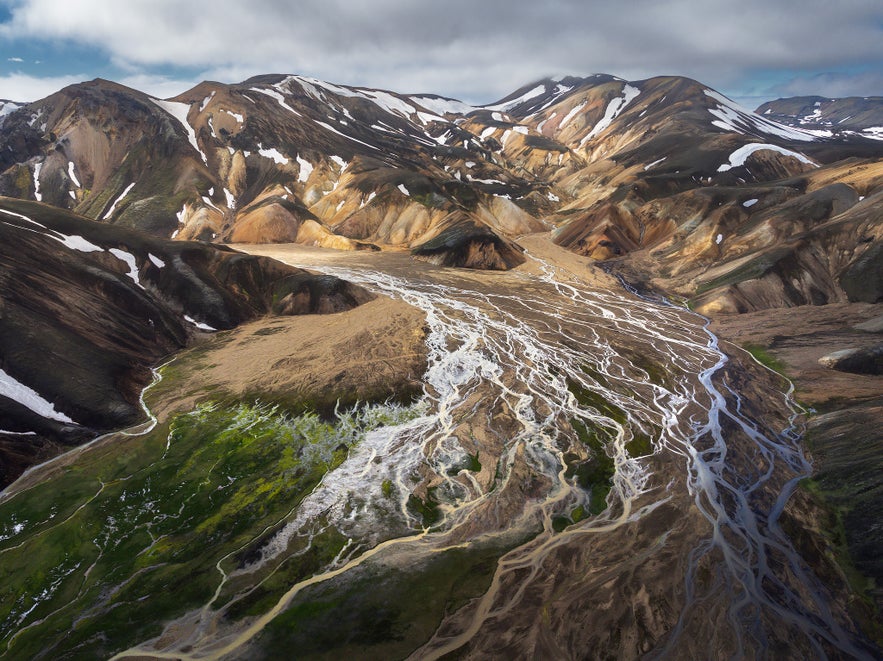 Visiting the Highlands is one of the most incredible things to do in Iceland. This vast wilderness is filled with rhyolite mountains, steaming valleys, black sand deserts, and glacial rivers. Hiking is the most popular way to experience the region, and the dramatic scenery makes every trail memorable.
Visiting the Highlands is one of the most incredible things to do in Iceland. This vast wilderness is filled with rhyolite mountains, steaming valleys, black sand deserts, and glacial rivers. Hiking is the most popular way to experience the region, and the dramatic scenery makes every trail memorable.
There are countless places to explore, but three stand out as the most popular: Landmannalaugar, with its multicolored mountains and hot springs, Thorsmork, a lush valley between glaciers, and Kerlingarfjoll, a geothermal wonderland of red hills and steaming vents. Each of them can be visited on day tours or longer multi-day adventures.
Driving into the Highlands is only possible in summer, when snow clears the F-roads (mountain tracks). If you’re driving yourself, you’ll need to rent a 4x4 vehicle. Make sure to familiarize yourself with driving F-roads in Iceland and plan the route carefully in advance, as rough terrain is common.
 Joining guided Highland tours is a safer option for inexperienced drivers in Iceland. Here are three popular Highland day tours, perfect for travelers who are limited on time:
Joining guided Highland tours is a safer option for inexperienced drivers in Iceland. Here are three popular Highland day tours, perfect for travelers who are limited on time:
-
Landmannalaugar Super Jeep Tour from Reykjavik – Discover the colorful rhyolite mountains of Landmannalaugar and finish the day with a soak in a natural hot spring.
-
Thorsmork Valley Super Jeep & Highlands Hiking Tour – Explore the dramatic “Valley of Thor,” surrounded by glaciers and forested ridges, on a guided super jeep and hiking adventure.
-
Day Tour to Kerlingarfjoll Mountains with Hveradalir Hike – Visit Kerlingarfjoll’s steaming valleys and colorful mountains, with time for hiking and a relaxing soak in geothermal baths.
In summer, scheduled highland bus transfers also run to Landmannalaugar and Thorsmork, making these areas accessible even if you don’t plan to rent a 4x4 or join a guided tour. This is especially convenient for hikers who plan to do the famous multi-day Laugavegur hike.
9. Experience the Natural Wonders of North Iceland and Go Whale Watching
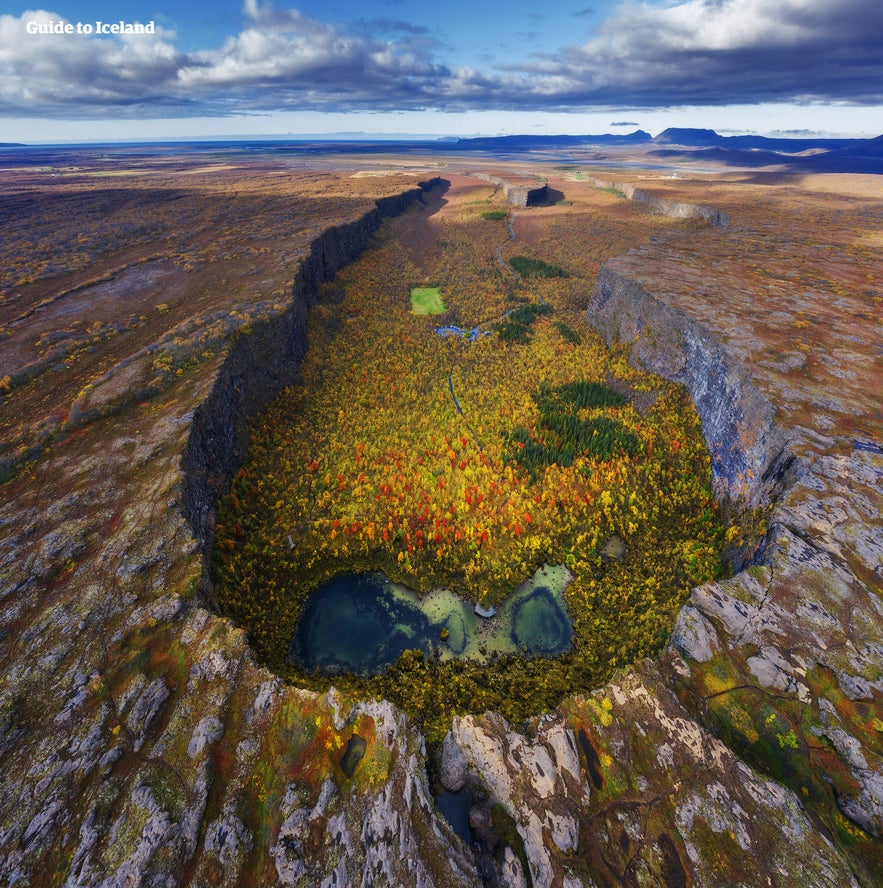
North Iceland offers some of the most unique things to do in Iceland, combining dramatic nature with authentic small-town charm.
The must-see destinations in North Iceland include thundering waterfalls, volcanic scenery, quiet fishing villages, and abundant wildlife like whales, seals, and birds.
Akureyri, Iceland's second-largest town after Reykjavik, makes a great base for exploring the north. From here, you can join Akureyri day tours and follow them up with visits to Akureyri's best restaurants and landmarks.
While two days are enough to see the highlights, spending three or four days in North Iceland allows for a more relaxed trip with time to enjoy hidden gems. If you're short on time, take a domestic flight from Reykjavik and rent a car in Akureyri.
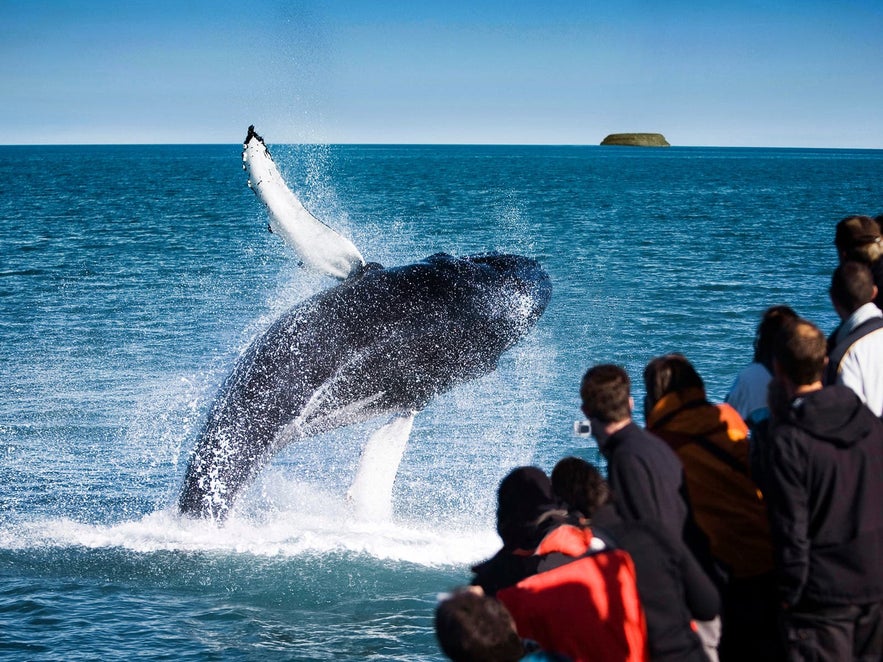
The Diamond Circle connects many of the top sights in North Iceland, including waterfalls, canyons, and geothermal areas. It can be explored by car or on Diamond Circle tours and normally features the following stops:
-
Godafoss Waterfall – A wide, curved waterfall known as the “Waterfall of the Gods.”
-
Husavik Whale Watching -Explore marine wildlife from the whale watching capital of Europe.
-
Asbyrgi Canyon – Horseshoe-shaped canyon tied to Norse mythology, with trails and views.
-
Dettifoss Waterfall – Europe's most powerful waterfall, located in Vatnajokull National Park.
-
Lake Myvatn – Incredible landscape with lava fields, steaming vents, craters, and birdlife.
There are many unique places to explore in Lake Myvatn, from folklore-rich lava formations like Dimmuborgir to the Game of Thrones-famous Grjotagja Cave. Add adventurous Lake Myvatn tours to the itinerary, and it’s easy to see why travelers often spend a full day here.
If you have more time, travel the Arctic Coast Way, an off-the-beaten-path route that hugs the northern coastline and adds scenic stops like Siglufjordur and Hvitserkur Sea Stack.
8. Stroll Along Reykjavik’s Shopping Streets and Visit Top Landmarks
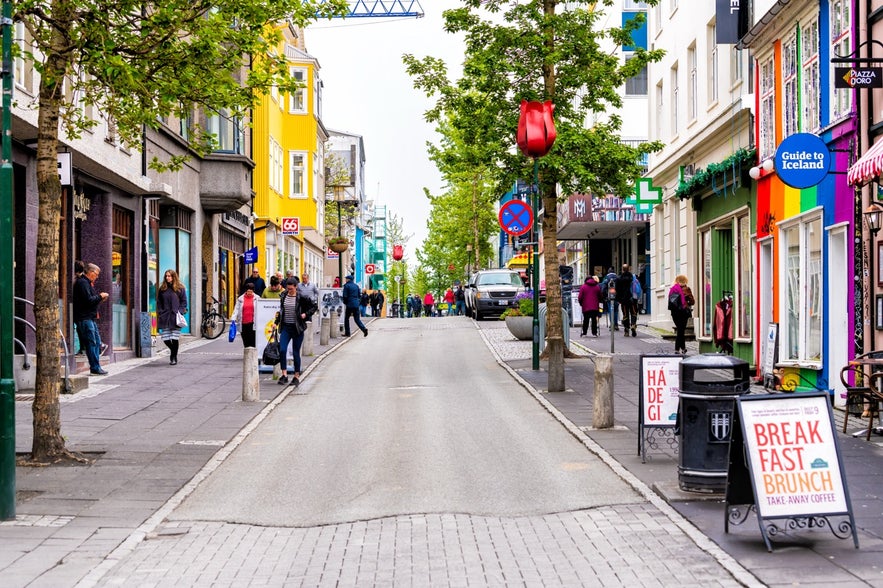
Downtown Reykjavik is compact and walkable, filled with colorful houses, boutique shops, and lively cafés. Stroll down Laugavegur Street, the city’s main shopping area, where you’ll find local design stores, cozy bookshops, and the perfect Icelandic souvenirs. For more inspiration, see our full guide to Reykjavik’s best shopping.
You can explore more of the cultural side of the city with visits to the top museums in Reykjavik, or enjoy a self-guided walk past Reykjavik’s colorful murals and street art.
If you’re a foodie, check out the best restaurants in Reykjavik, where you can try everything from Icelandic lamb and seafood to modern Nordic cuisine.
Don’t miss out on Reykjavik’s nightlife. From cocktail lounges to live music venues, the best bars in Reykjavik make evenings as exciting as the days.
In between enjoying the food, shops, and culture, take time to experience the top things to do in Reykjavik and see the city’s most iconic landmarks, including the following:
-
Hallgrimskirkja Church – Ride the elevator to the tower for panoramic city views.
-
Harpa Concert Hall – Admire the glass facade and catch the evening light over the bay.
-
Sun Voyager Sculpture – Snap photos of the steel landmark shaped like a Viking ship.
-
Reykjavik Old Harbour – Stroll the lively waterfront and join boat tours.
-
Perlan Museum – Explore exhibitions inside the glass dome and enjoy hilltop views.
Experience more by checking in at one of the best accommodations in Reykjavik. Some travelers find it most convenient to use the capital as a base and embark on day tours to see the rest of the country.
7. Chase Waterfalls, Beaches, and Glaciers on Iceland’s Famous South Coast and Ride an Icelandic Horse
Iceland’s South Coast is one of the most popular regions to visit. It’s easy to reach from Reykjavik and is packed with natural sights like waterfalls, black sand beaches, glaciers, and ocean cliffs. The area was shaped by volcanoes and glacial floods, creating wide open plains and dramatic coastlines.
You can explore the region independently on self-drive excursions, or you can join guided South Coast adventures for a more relaxed experience with local insights. Some of the most popular places to visit along the South Coast include:
-
Seljalandsfoss Waterfall – Known for the unique views from the path behind the cascade.
-
Skogafoss Waterfall – A powerful and photogenic waterfall, often highlighted by a rainbow.
-
Solheimajokull Glacier – A glacier where you can join hiking or ice climbing tours.
-
Reynisfjara Black Sand Beach – Famous for its basalt columns and powerful sneaker waves.
-
Fjadrargljufur Canyon – A narrow, green canyon with walking paths and viewpoints.
-
Jokulsarlon Glacier Lagoon – A famous lake with floating icebergs, next to Diamond Beach.
Less visited but just as beautiful sights include Dyraholey Peninsula, one of the best places to see puffins in Iceland during summer, and Gljufrabui Waterfall, a hidden waterfall concealed by a cliff.
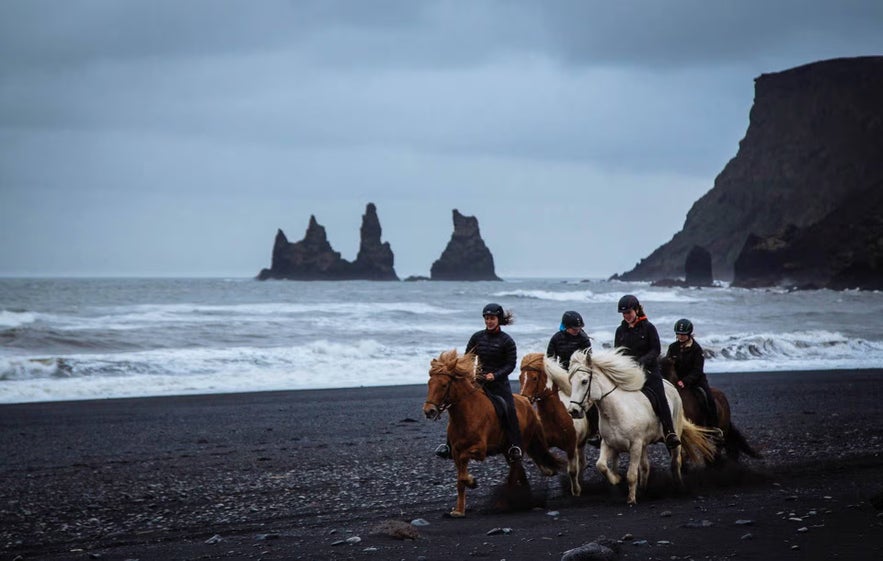 Few experiences capture the spirit of Iceland better than riding an Icelandic horse across a remote black-sand beach, with the ocean on one side and jagged cliffs on the other.
Few experiences capture the spirit of Iceland better than riding an Icelandic horse across a remote black-sand beach, with the ocean on one side and jagged cliffs on the other.
These small, sturdy horses are beloved for their gentle temperament and unique "tölt" gait, a smooth, gliding stride perfect for both beginners and experienced riders.
Trotting through otherworldly landscapes on horse riding tours is one of the best things to do in Iceland to slow down and connect with nature. One of the most memorable ways to enjoy this is with a scenic riding tour on the black sand beach from Vik.
The tour is one of the best things to do in Vik, and it's suitable for all skill levels, making it an accessible adventure for couples, families, and solo travelers alike. After your adventure, grab a meal at one of the top restaurants in Vik.
6. Explore Vatnajokull National Park and Go Glacier Hiking in Skaftafell
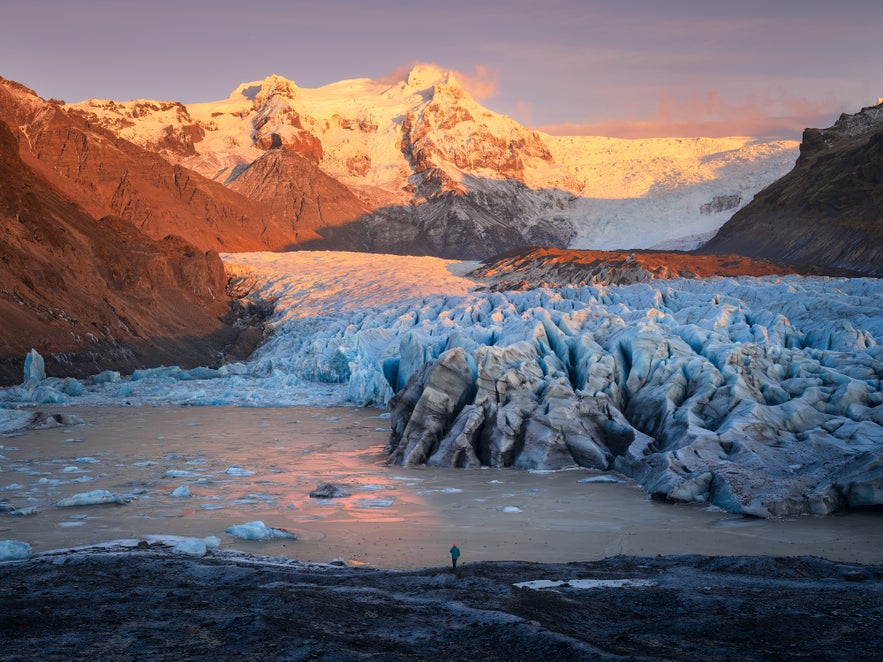
About two hours east of Vik lies Vatnajokull Glacier, the largest in Europe, covering 8% of Iceland. Exploring this glacier is one of the most unforgettable things to do in Iceland. From Vatnajokull National Park, you can join various glacier tours, including hikes and visits to Iceland's ice caves.
Reaching Vatnajokull Glacier from Reykjavik is, in our opinion, one of the most stunning stretches of the Ring Road. The scenery shifts from lush mountains and farmland to a sudden vast black sand desert, where the icy Vatnajokull Glacier grows ever larger as you travel east.
The best gateway to Vatnajokull is Skaftafell Nature Reserve. Once its own national park, Skaftafell is now part of Vatnajokull National Park and offers trails for every level. A must-do is the walk to Svartifoss, a striking waterfall framed by black basalt columns.
Skaftafell is also the main base for glacier hiking tours on Vatnajokull. The most popular tours in Skaftafell take you onto the glacier, where you’ll wear crampons and follow a certified glacier guide on safe routes across dramatic scenery. These are the best-rated glacier hiking tours:
-
Beginner-Friendly Glacier Walk in Skaftafell – Designed for all experience levels, this short and easy glacier walk includes a gentle hike onto the ice with expert guidance.
-
The Skaftafell Glacier Hiking Tour – A three-hour adventure where you’ll explore the glacier while learning about how it formed and has changed over the years.
-
The 5-Hour Skaftafell Glacier Hiking Tour – Perfect for adventurous travelers, this extended hike takes you further onto the glacier to explore ice walls and remote sections.
If you're based closer to Reykjavik or short on time, a glacier hiking tour on Solheimajokull is a more accessible choice. Solheimajokull Glacier is located west of Vik. You can also find tour options combined with sightseeing, like this South Coast adventure with glacier hiking.
5. Take a Boat Tour on Jokulsarlon Glacier Lagoon and See The Diamond Beach
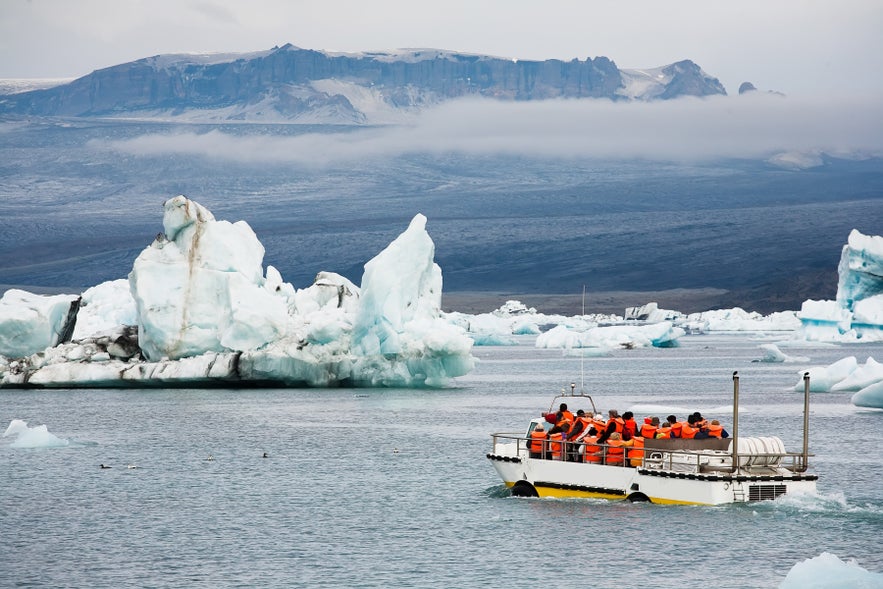 Jokulsarlon Glacier Lagoon is one of Iceland’s most famous natural wonders and a bucket-list place to visit. Here, icebergs break off from Breidamerkurjokull, an outlet of Vatnajokull Glacier, and slowly drift across the glacial lagoon before reaching the sea.
Jokulsarlon Glacier Lagoon is one of Iceland’s most famous natural wonders and a bucket-list place to visit. Here, icebergs break off from Breidamerkurjokull, an outlet of Vatnajokull Glacier, and slowly drift across the glacial lagoon before reaching the sea.
The best way to experience Jokulsarlon Glacier Lagoon is by getting out on the water. Surrounded by towering icebergs and framed by the edge of Vatnajokull Glacier, the lagoon is even more impressive. These are the most popular Jokulsarlon tours for a closer look at the ice:
-
Jokulsarlon Glacier Lagoon Boat Tour – This classic boat tour offers a relaxing ride through the lagoon, with expert commentary as you float among icebergs and spot wildlife.
-
Zodiac Boat Tour on Jokulsarlon Glacier Lagoon – Step aboard a smaller and faster boat that takes you even closer to the icebergs and glacier’s edge, perfect for adventure-seekers.
-
Kayaking in Jokulsarlon Glacier Lagoon – Paddle between icebergs on a guided kayaking tour for a peaceful, up-close experience with the lagoon’s beauty.
Boat tours at Jokulsarlon are normally available from spring through fall. In winter, the ice cave season takes over.

When the icebergs of Jokulsarlon Glacier Lagoon finally reach the sea, the waves push them onto the black volcanic beach nicknamed the Diamond Beach, and the result is mesmerizing.
The blue of the ice and the white of the surf contrast with the black sand and make Diamond Beach exceptionally beautiful and one of Iceland’s best places to visit.
Add the colors of the northern lights over Jokulsarlon or the dramatic hues of the midnight sun, and you have a view that looks like something from a fantasy novel. As if that wasn’t enough, sometimes you can also spot seals playing in the lagoon and out at sea!
4. Explore Iceland’s Blue Ice Caves in Winter
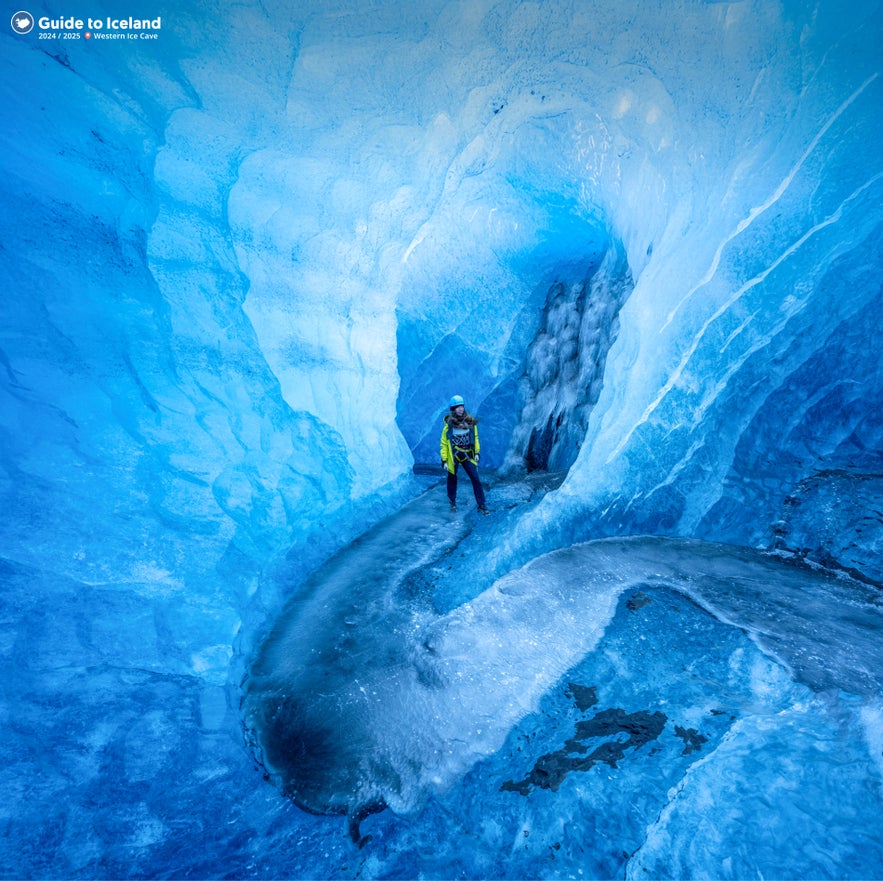
In the colder months, Iceland's ice caves offer some of the most magical experiences. Each winter in Iceland, new ice caves form naturally, carved out by meltwater flowing beneath the glacier during summer. Because the caves shift and change each year, no two ice cave seasons are ever the same.
There are three main locations where you can visit ice caves in Iceland:
-
Vatnajokull Glacier – Iceland’s largest glacier and the best area for natural ice caves.
-
Myrdalsjokull Glacier – Home to the only ice cave that is accessible year-round in Iceland.
-
Langjokull Glacier – Located in West Iceland, featuring man-made ice tunnels.
Ice caves in Iceland can only be accessed on guided ice cave tours, as conditions inside the glaciers are constantly changing and safety is a top priority. Luckily, there are several highly rated options available, from short and easy walks into the ice to longer adventures deep inside the glacier.
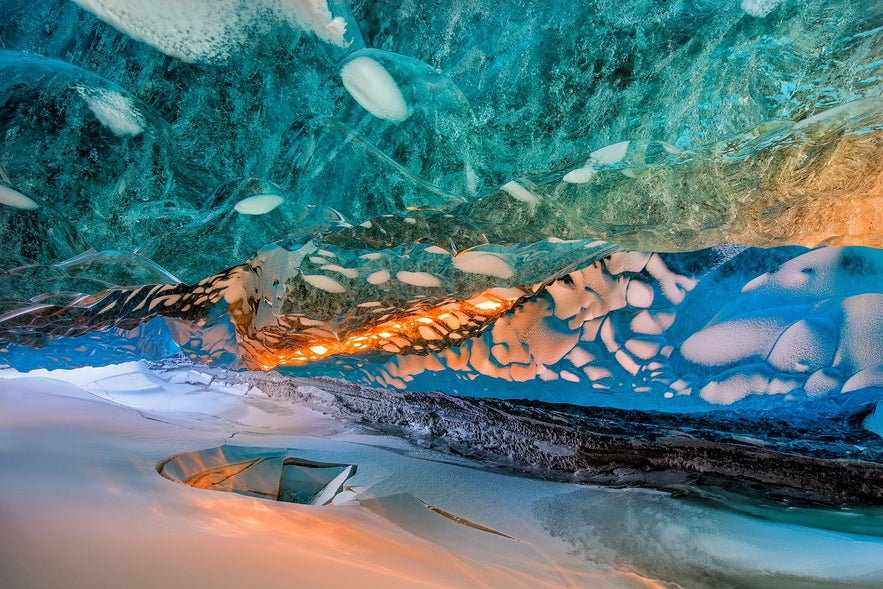 The most popular tours depart from Jokulsarlon Glacier Lagoon, including the best-rated experience, the Crystal Blue Ice Cave Tour in Vatnajokull Glacier. Inside, walls of blue ice glow in the light, with frozen textures and patterns that change each season.
The most popular tours depart from Jokulsarlon Glacier Lagoon, including the best-rated experience, the Crystal Blue Ice Cave Tour in Vatnajokull Glacier. Inside, walls of blue ice glow in the light, with frozen textures and patterns that change each season.
Another epic experience is the Katla Ice Cave tour, near Vik. This natural ice cave, beneath Myrdalsjokull Glacier, is the only one that is open year-round. The layers of blue and black ice shaped by Katla Volcano create a dramatic setting that is very different from the Vatnajokull Glacier.
For travelers based in Reykjavik, the Into the Glacier Ice Cave tour in Langjokull Glacier offers a unique alternative. These man-made passages lead you deep inside the ice, where you can walk through illuminated chambers and learn about the massive glacier’s structure from within.
3. Journey Around the Famous Golden Circle With Secret Detours
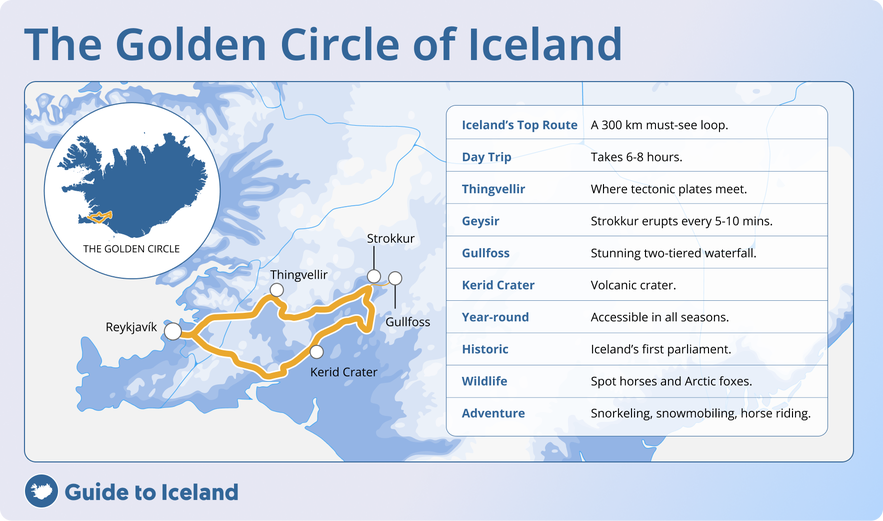
The first stop, Tingvellir National Park, is a UNESCO World Heritage Site with both natural and historical significance. It’s where Iceland’s first parliament met in 930 AD, and it sits in a stunning rift valley between the North American and Eurasian tectonic plates with stunning surroundings.
Not far away, the Geysir Geothermal Area is home to the geyser that gave all others their name. While the original Geysir is now mostly inactive, its neighbor Strokkur erupts every five minutes, sending boiling water more than 65 feet (20 meters) into the air.
The final main stop, Gullfoss Waterfall, is Iceland’s most famous cascade. It plunges dramatically in two tiers into a glacial canyon formed during the last ice age. On sunny days, the mist often catches the light, creating vivid rainbows.
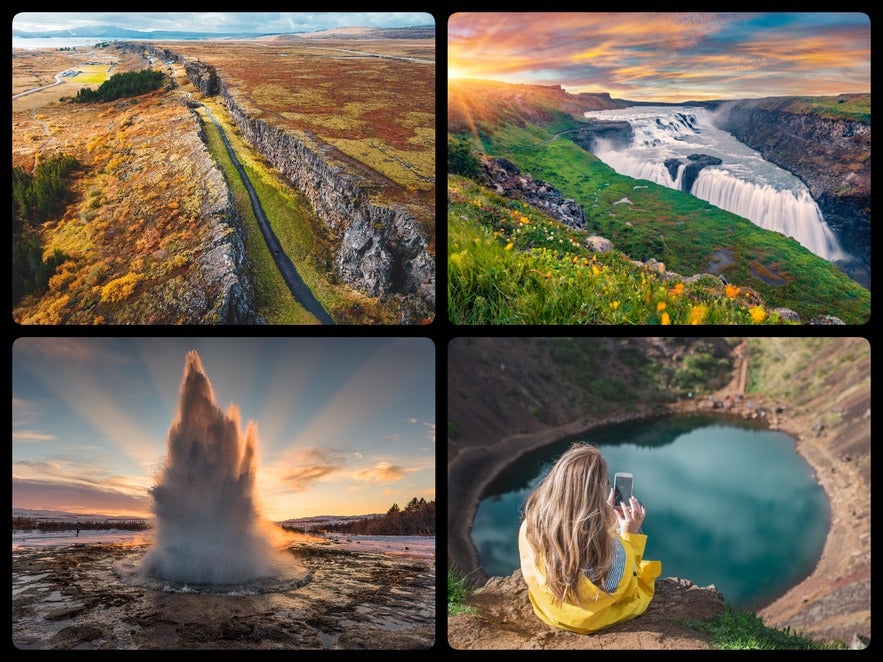 Many visitors choose to rent a car so that they can drive the Golden Circle on their own, often staying a night in Golden Circle accommodations.
Many visitors choose to rent a car so that they can drive the Golden Circle on their own, often staying a night in Golden Circle accommodations.
If you have extra time on your Golden Circle itinerary, there are many lesser-known detours that can make the route even more fun:
-
Kerid Crater – Circle a colorful volcanic lake along the crater rim.
-
Bruarfoss Waterfall – Hike a scenic trail to a vivid blue cascade.
-
Laugaras Lagoon – Soak in geothermal pools surrounded by beautiful views.
-
Laugarvatn Fontana Spa – Enjoy hot spring baths and lakeside steam rooms.
-
Secret Lagoon – Bathe in one of Iceland’s oldest natural hot springs.
-
Fridheimar Greenhouse – Eat tomato-based dishes at a geothermal farm.
-
Snorkeling in Silfra – Float between two continents in crystal-clear waters.
-
Snowmobiling on Langjokull Glacier – Ride across Iceland’s second-largest glacier.
-
Horseback riding near Fludir – Meet Icelandic horses and explore scenic countryside.
2. Relax in Iceland’s Top Hot Springs like the Blue Lagoon

No trip to Iceland is complete without experiencing one of its world-famous geothermal spas. At the top of the list is the Blue Lagoon, a globally recognized bucket-list travel experience that draws visitors from all over the world.
Beyond the spas, you’ll also find natural hot springs across the countryside. These hidden pools offer a raw and authentic way to enjoy Iceland’s geothermal energy.
Hot spring bathing has been part of Icelandic culture for centuries, offering a way to unwind, socialize, and enjoy the healing properties of mineral-rich waters.
Today, visiting top hot springs and geothermal spas in Iceland is one of the most relaxing things travelers can do, combining natural wellness with unforgettable scenery.
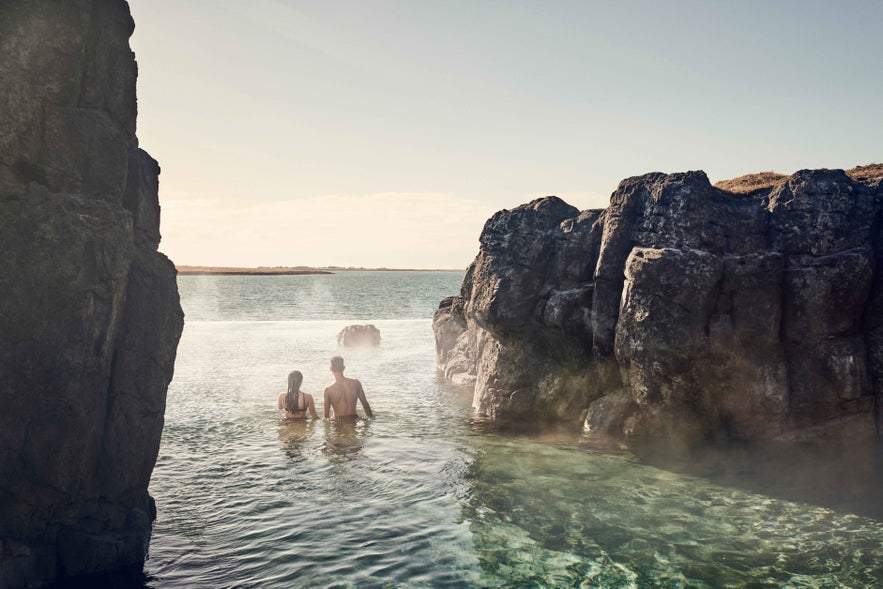
The best geothermal spas in Iceland include:
-
Blue Lagoon – Soak in Iceland’s most iconic geothermal spa, where milky blue waters surrounded by lava fields make for the perfect first or last stop near Keflavik Airport.
-
Sky Lagoon – Float in an oceanside infinity pool just outside Reykjavik and experience the unique seven-step spa ritual with sweeping views of the North Atlantic.
-
Laugaras Lagoon – Combine Golden Circle sightseeing with a visit to Iceland’s newest spa, where geothermal pools, saunas, and nature views offer the ultimate relaxation.
-
Hvammsvik Hot Springs – Bathe in oceanside pools that rise and fall with the tide in Hvalfjordur, blending geothermal warmth with raw Icelandic nature.
-
Forest Lagoon – Unwind in birch-lined pools near Akureyri, complete with swim-up bars and fjord views, making it the perfect hot spring stop in North Iceland.
-
Earth Lagoon – Relax in mineral-rich waters overlooking volcanic landscapes, the North’s answer to the world-famous Blue Lagoon.
-
Vok Baths – Slip into geothermal pools that float on Lake Urridavatn in East Iceland, where you can combine hot soaking with refreshing cold-water dips.
For premium ticket options and included transfers, explore the complete selection of hot spring tours and tickets in Iceland. If you’re looking for a more budget-friendly geothermal bathing experience, the local swimming pools in Reykjavik offer an excellent alternative.
1. Hunt the Northern Lights in Iceland’s Winter Skies
The best thing to do in Iceland in winter is to hunt for the northern lights.
Because of its Arctic location, Iceland is one of the best places in the world to see the auroras. This breathtaking display of swirling green, pink, and purple lights dancing across the Icelandic sky can be witnessed from September to April.
If you’re lucky, you’ll see the northern lights shimmer above waterfalls, glaciers, and lava fields, turning the landscape into a natural spectacle you’ll never forget.
To see the northern lights, the conditions need to be right: clear skies, solar activity, and low light pollution. If the activity is strong, you can sometimes even see the northern lights in Reykjavik!
If you're considering winter self-drive tours and will have access to a rental car, you can easily hunt for them yourself. You just need to head to dark areas and follow the northern lights forecast for activity and the cloud cover forecast for clear skies.
Many travelers opt for guided northern lights tours for convenience, where experienced guides bring you straight to the best aurora viewing places each night. Here are some of the most popular northern lights tours from Reykjavik:
-
Northern Lights Bus Tour from Reykjavik – A convenient and budget-friendly option that takes you to a dark-sky location outside the city with a knowledgeable guide.
-
Northern Lights Boat Cruise from Reykjavik – Sail into Faxafloi Bay for open views away from city lights, with a heated cabin and warm overalls provided.
-
Northern Lights Super Jeep Tour from Reykjavik – Venture off the beaten path in a Super Jeep with a professional guide and get free photos of you with the northern lights.
The northern lights are one of the most unforgettable experiences you can have in Iceland. For tips on how to plan around the aurora season, check out our full guide on the best time to visit Iceland to see the northern lights.
Newest Things to Do in Iceland 2025
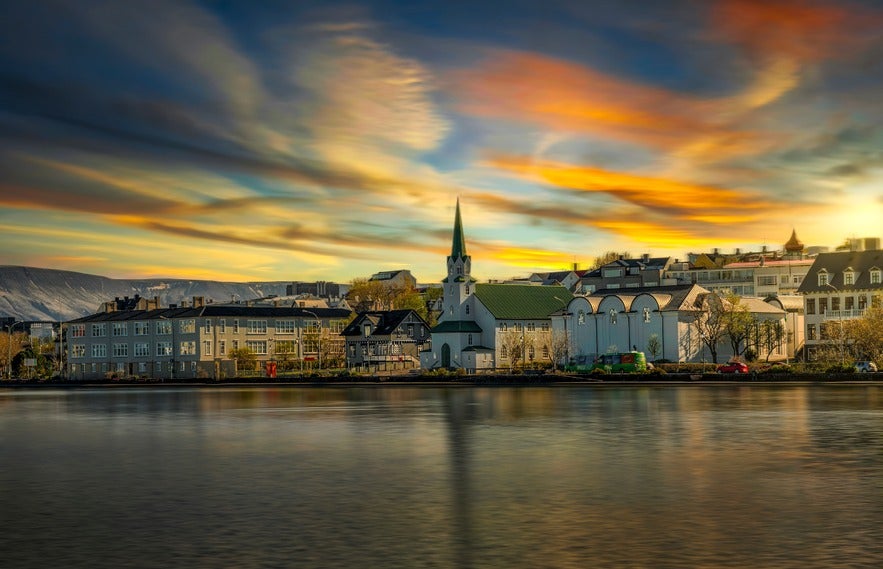 Iceland continues to add exciting new experiences for travelers, with several unique attractions having opened in 2024 or launching in 2025. These additions offer new ways to enjoy the country’s volcanic landscapes, highland adventures, coastal wildlife, and geothermal relaxation.
Iceland continues to add exciting new experiences for travelers, with several unique attractions having opened in 2024 or launching in 2025. These additions offer new ways to enjoy the country’s volcanic landscapes, highland adventures, coastal wildlife, and geothermal relaxation.
Relax at Laugaras Lagoon
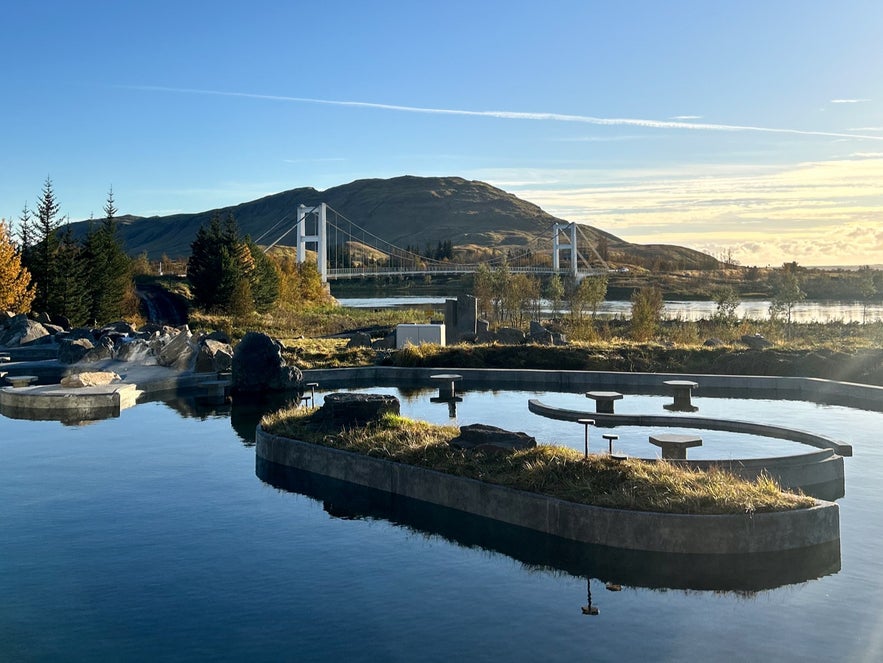 Iceland’s newest geothermal spa, the Laugaras Lagoon, is located along the Golden Circle and features tiered pools with forest and river views, steam rooms, cold plunges, a swim-up bar, and an on-site restaurant.
Iceland’s newest geothermal spa, the Laugaras Lagoon, is located along the Golden Circle and features tiered pools with forest and river views, steam rooms, cold plunges, a swim-up bar, and an on-site restaurant.
Designed as a quieter, more nature-focused alternative to the Blue Lagoon. It officially opened its doors on October 15th, 2025, and you can now book your Laugaras Lagoon ticket online.
Drive the Volcanic Way
 The Volcanic Way is a self-drive route through South Iceland and the Reykjanes Peninsula, divided into eight stages, each focused on a significant volcano. It connects 17 towns and villages from Keflavik to Hofn. Featured volcanoes include:
The Volcanic Way is a self-drive route through South Iceland and the Reykjanes Peninsula, divided into eight stages, each focused on a significant volcano. It connects 17 towns and villages from Keflavik to Hofn. Featured volcanoes include:
-
Fagradalsfjall – First site of the recent Reykjanes eruptions.
-
Hengill – A geothermal area near the Golden Circle.
-
Hekla – One of Iceland’s most active volcanoes.
-
Eyjafjallajokull – The volcano famous for its 2010 eruption.
-
Eldfell – Reshaped the Westman Islands in 1973.
-
Katla – Subglacial volcano under Myrdalsjokull Glacier.
-
Lakagigar – Known for the massive 1783 lava flow.
-
Oraefajokull – Known for a massive historical eruption.
Stay at the Kerlingarfjoll Highland Base
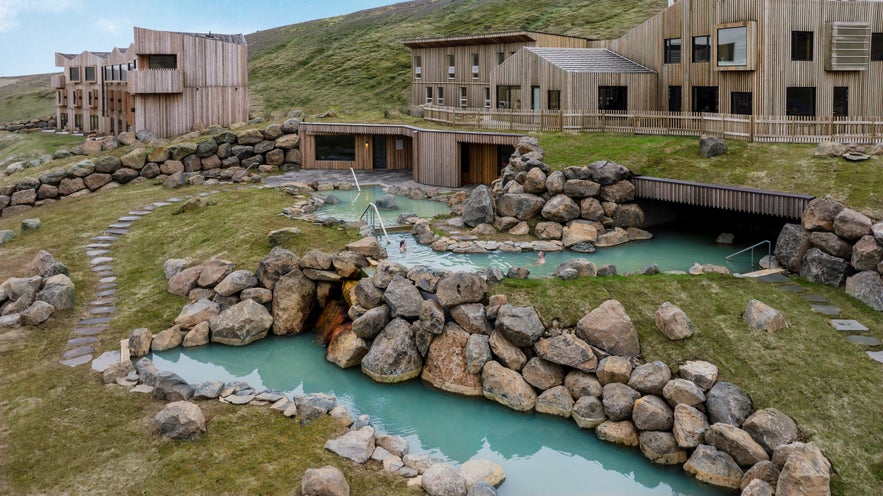 A new eco-friendly resort in the central highlands offering accommodation options from camping to luxury rooms. At Highland Base Kerlingarfjoll, you can enjoy the geothermal Highland Baths, hiking trails, stargazing, and guided highland excursions like this e-biking tour.
A new eco-friendly resort in the central highlands offering accommodation options from camping to luxury rooms. At Highland Base Kerlingarfjoll, you can enjoy the geothermal Highland Baths, hiking trails, stargazing, and guided highland excursions like this e-biking tour.
You can access with a 4x4 rental car or book a Highland Base transfer from Reykjavik.
Zipline on Solheimajokull Glacier
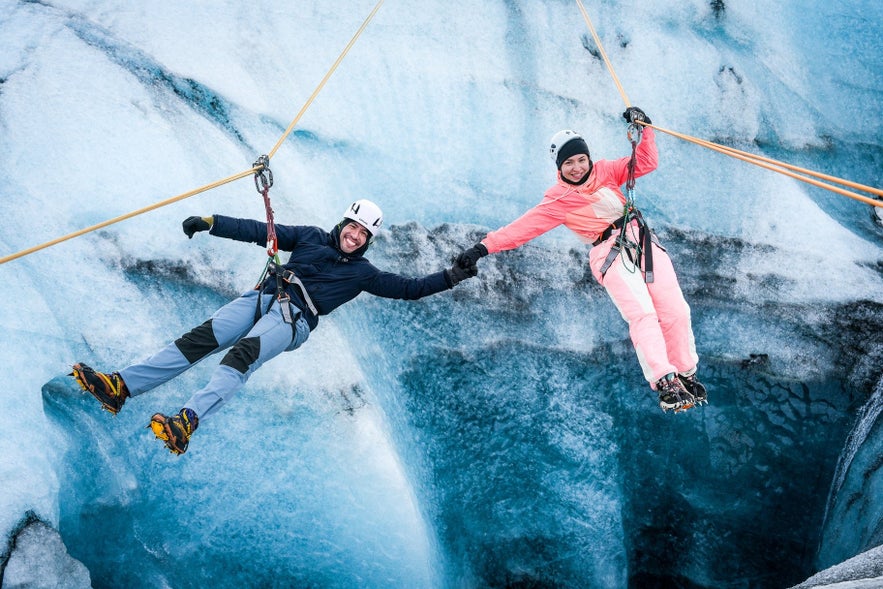 Experience a thrilling new glacier zipline adventure on the Solheimajokull Glacier on the South Coast.
Experience a thrilling new glacier zipline adventure on the Solheimajokull Glacier on the South Coast.
You'll hike up the glacier and soar over a moraine with stunning views of ice formations, surrounding mountains, and black sand plains.
Ride the Volcano Express in Harpa
The Volcano Express is a virtual experience inside Reykjavik’s Harpa Concert Hall. This immersive ride uses motion simulation and visual effects to showcase Iceland’s volcanic history in an exciting, accessible way. You'll want to book your Volcano Express tickets in advance.
Visit the Beluga Whale Sanctuary in the Westman Islands
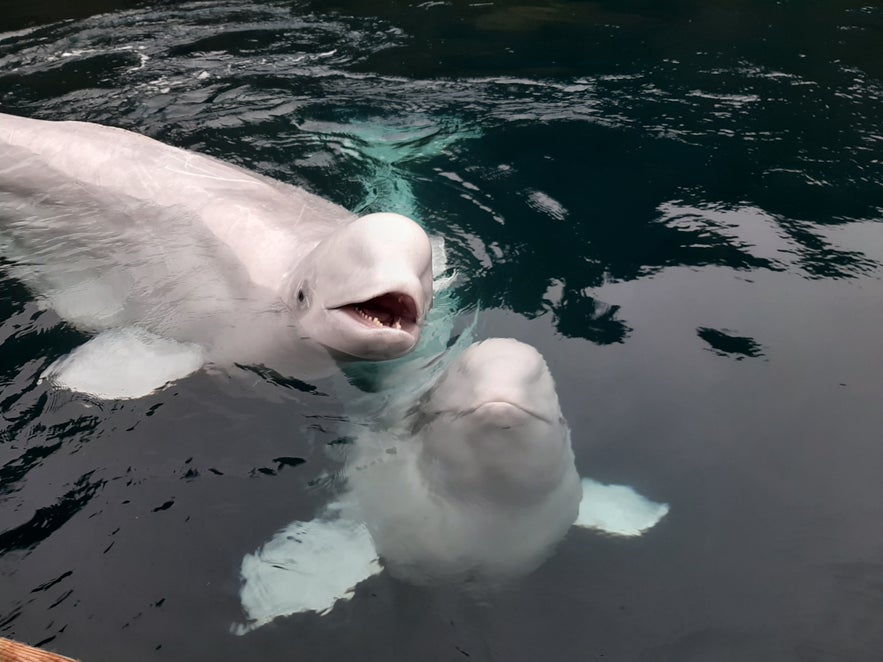
A Map of the Best Things To Do in Iceland
Your average sightseeing guide of Iceland is probably the size of a dictionary. There are so many unique Icelandic attractions and landscapes that fitting all of them into a holiday may seem like an impossible task. So, we’ve made a map of must-see places in Iceland above for you to reference!
What Should You Avoid in Iceland?
 There are some things to avoid in Iceland for various reasons. We’ve covered all of them in our dumbest things to do in Iceland.
There are some things to avoid in Iceland for various reasons. We’ve covered all of them in our dumbest things to do in Iceland.
In terms of places to avoid, we’re happy to say that all the attractions in Iceland are as pretty in real life as in photos. That said, the best thing to do to avoid disappointment is to book your visits in advance to famous Icelandic tourist spots such as the Blue Lagoon.
Make sure to respect nature when you're traveling in the countryside, don't leave litter, and keep it pristine like it has been for over 1000 years.
We hope this helps you find out where to go in Iceland and the best things to do to make the most of your stay here. Let us know your favorite natural attraction in Iceland, and share any hidden gems you discover while traveling across the unique landscape.

